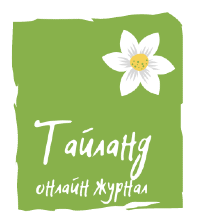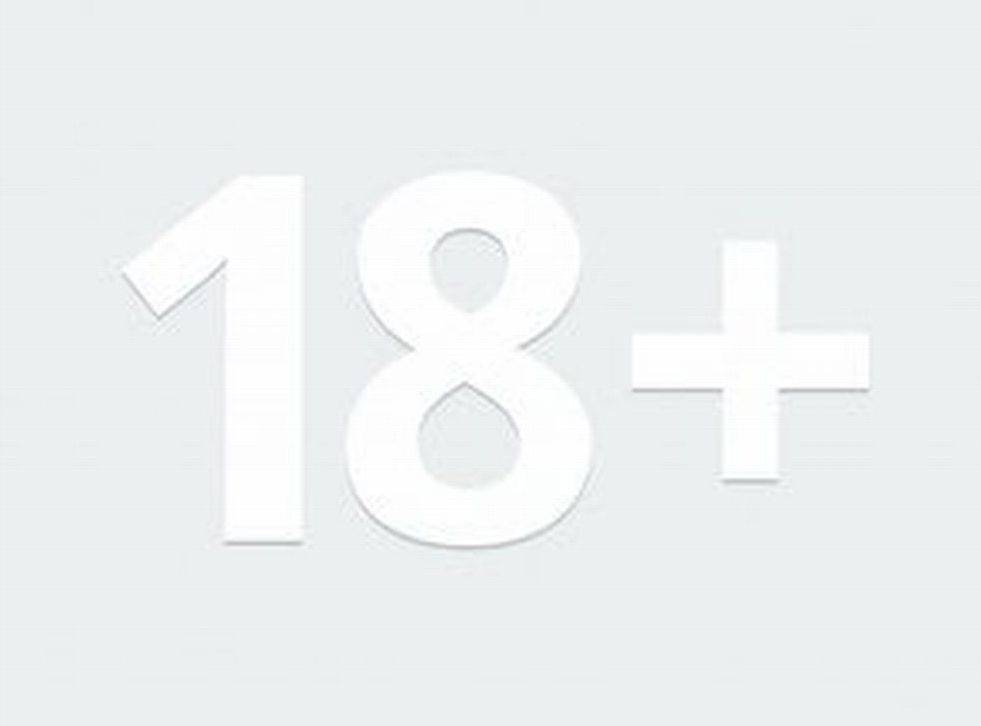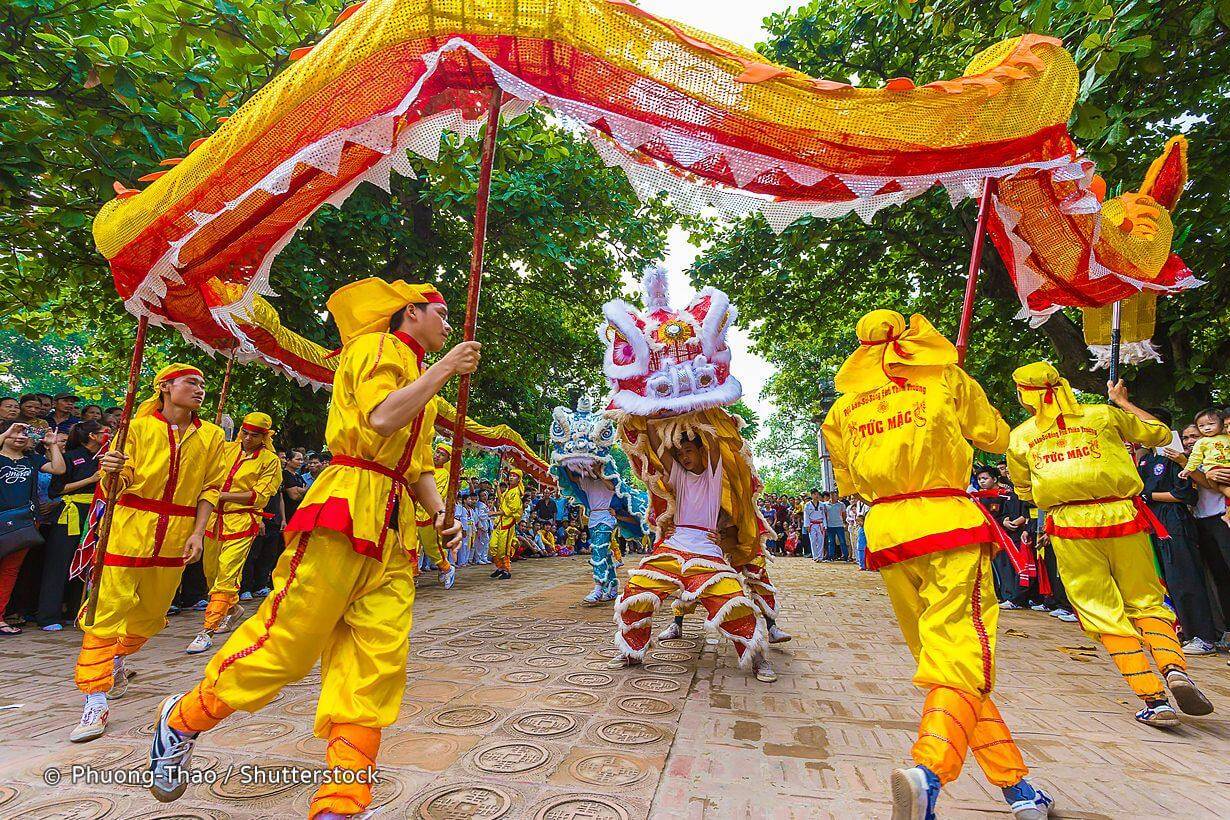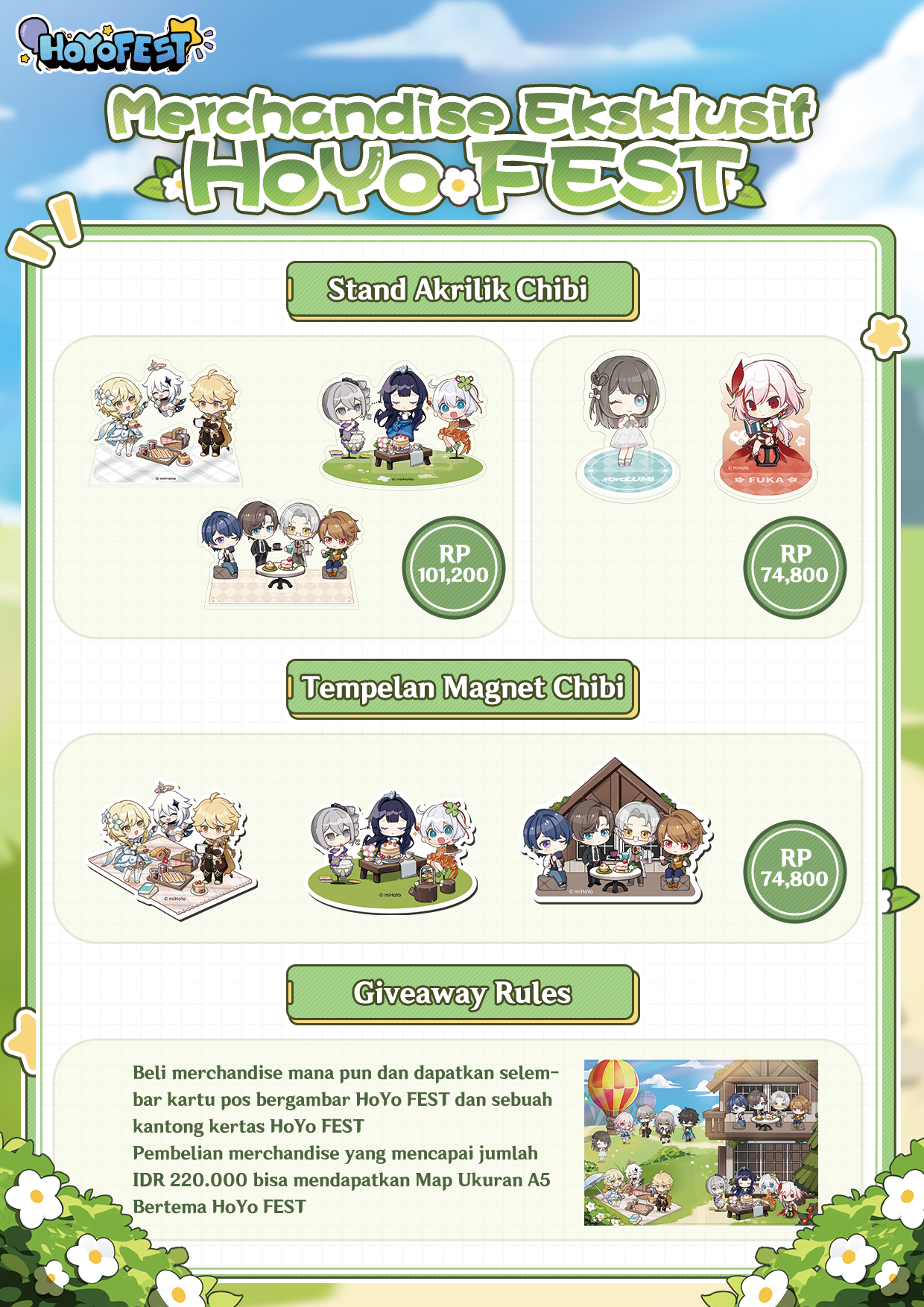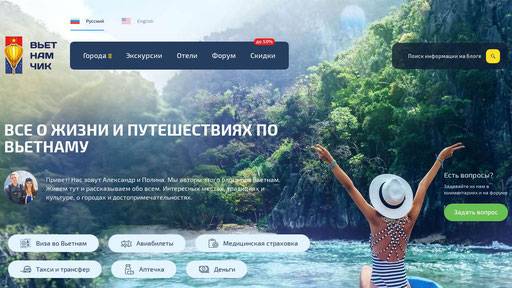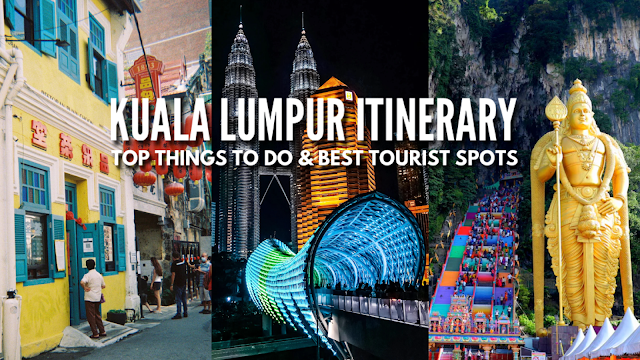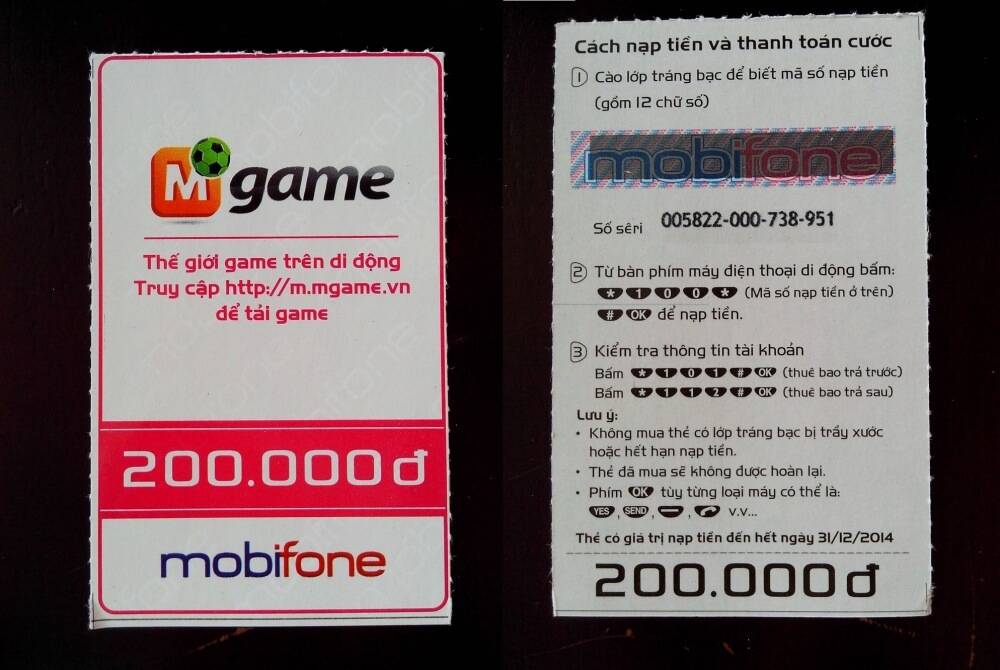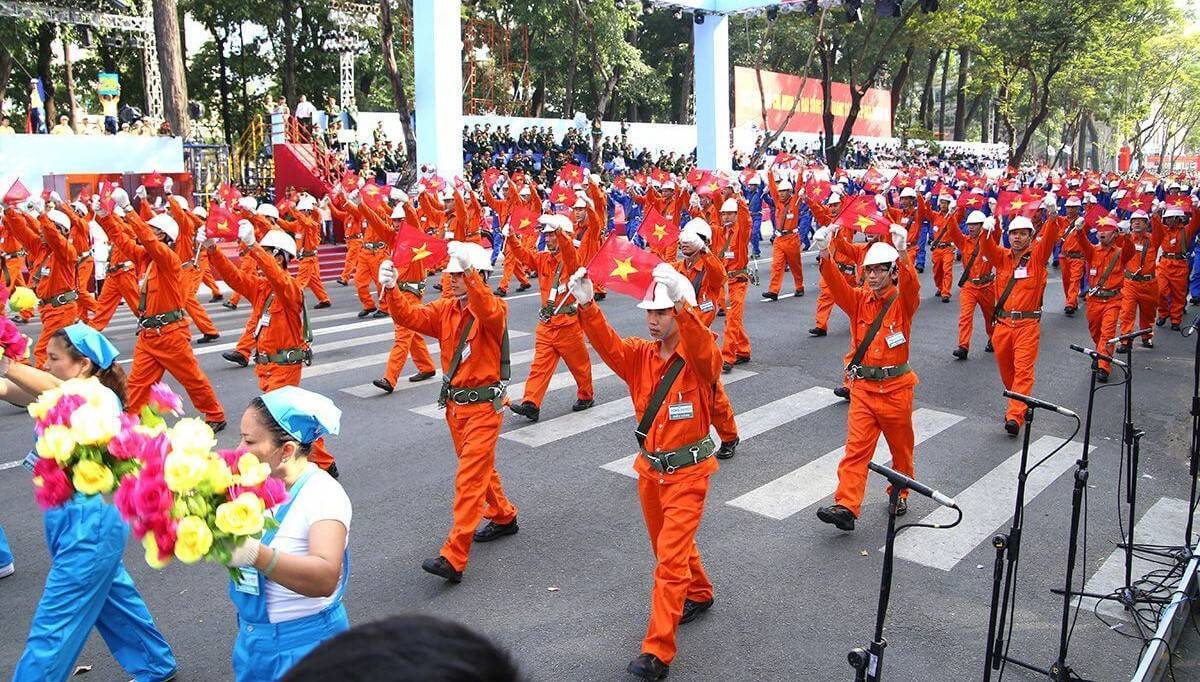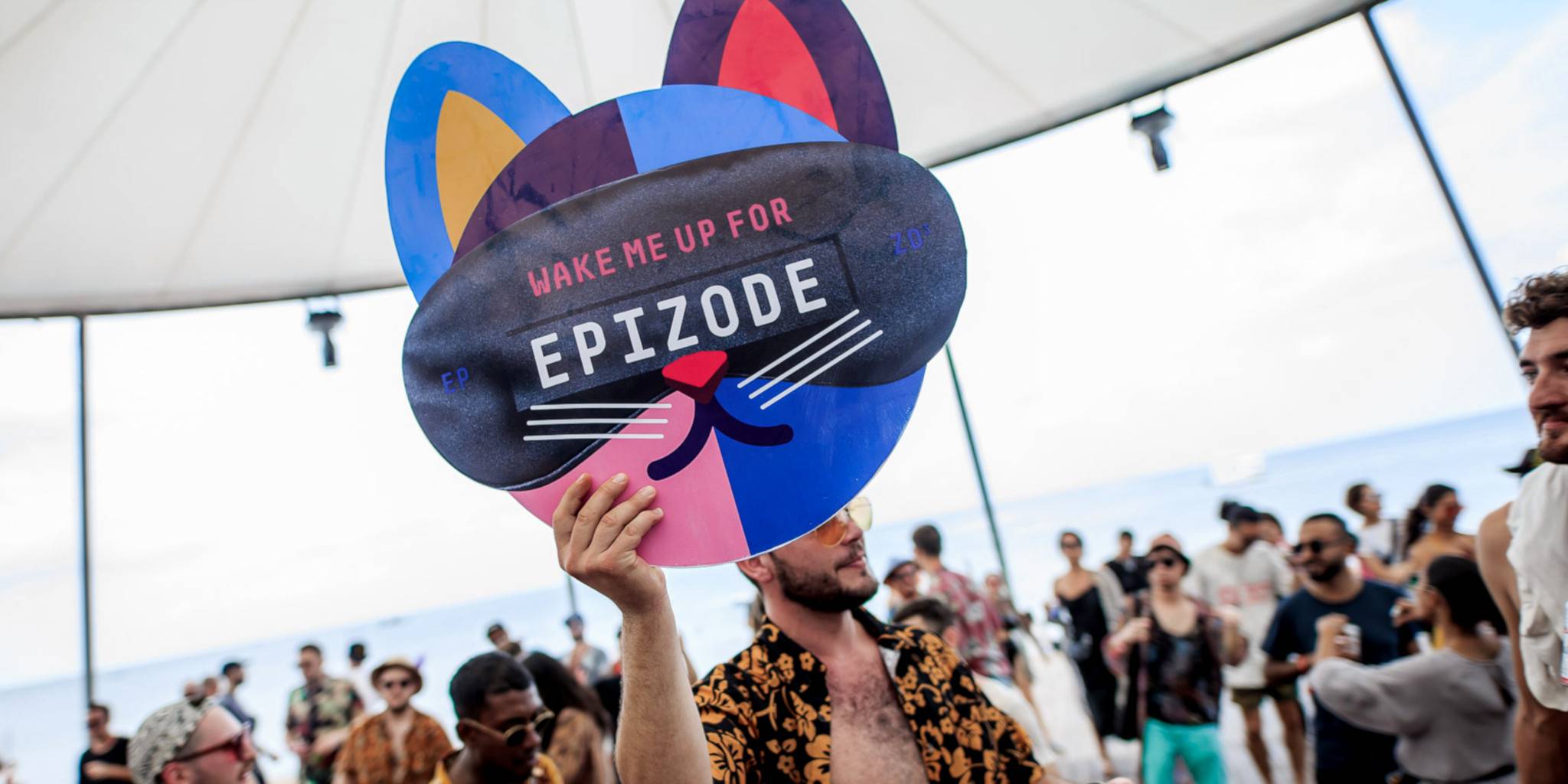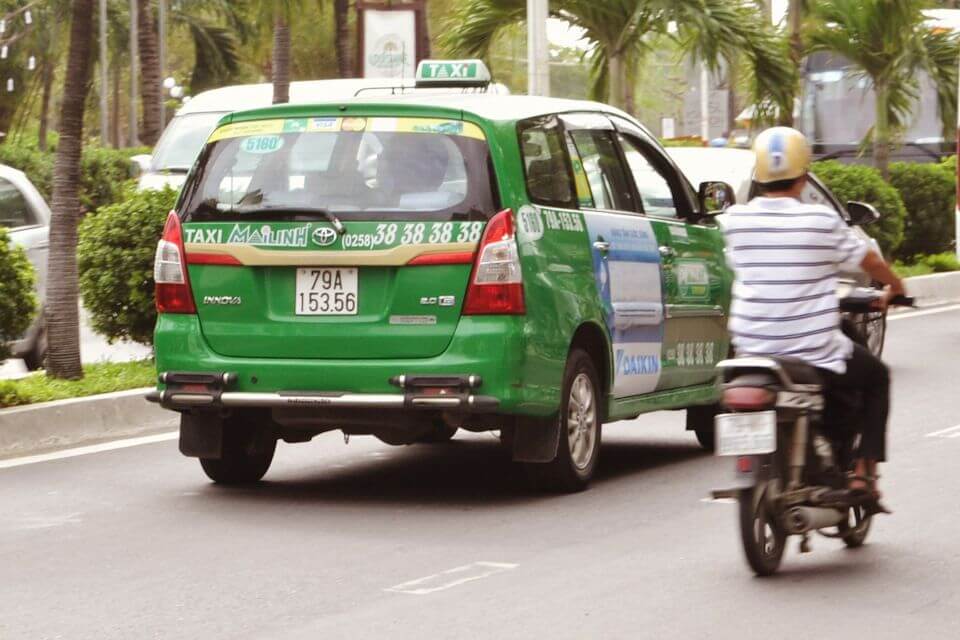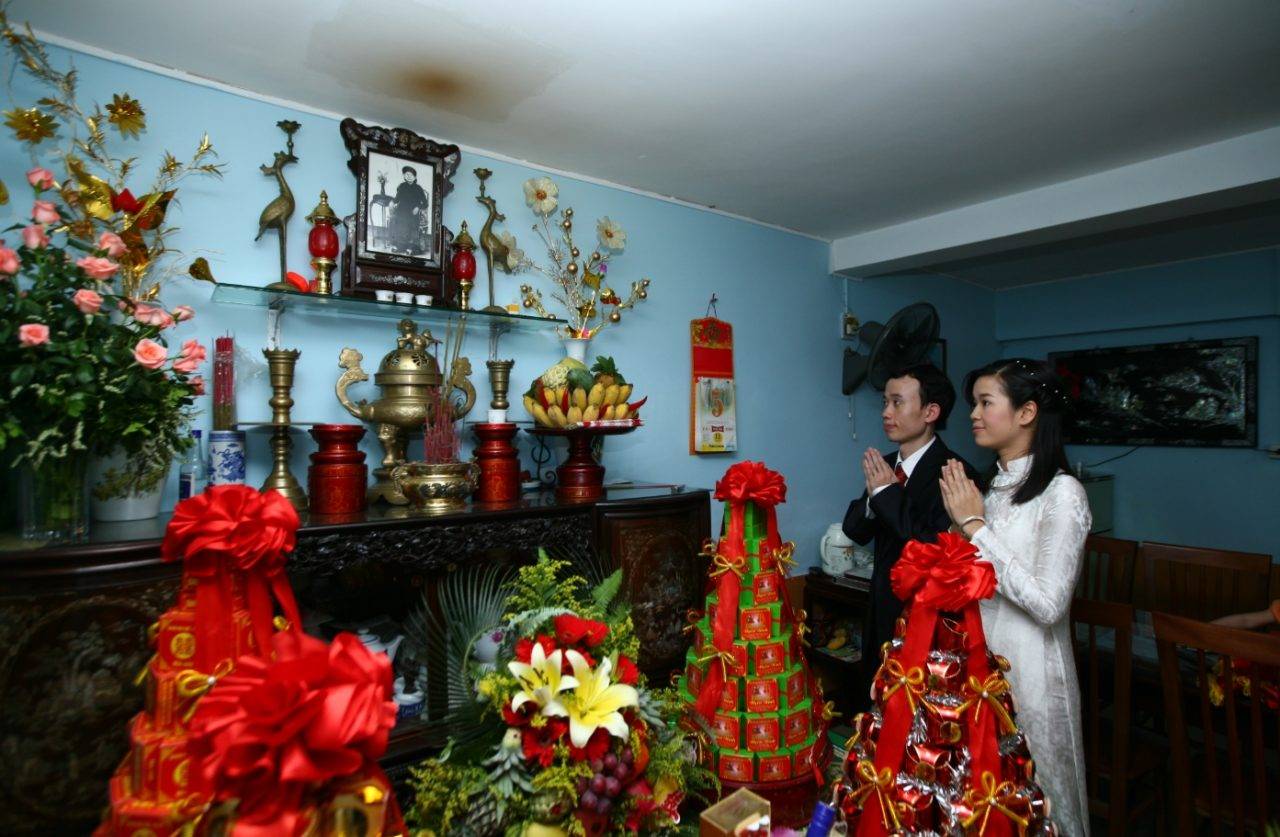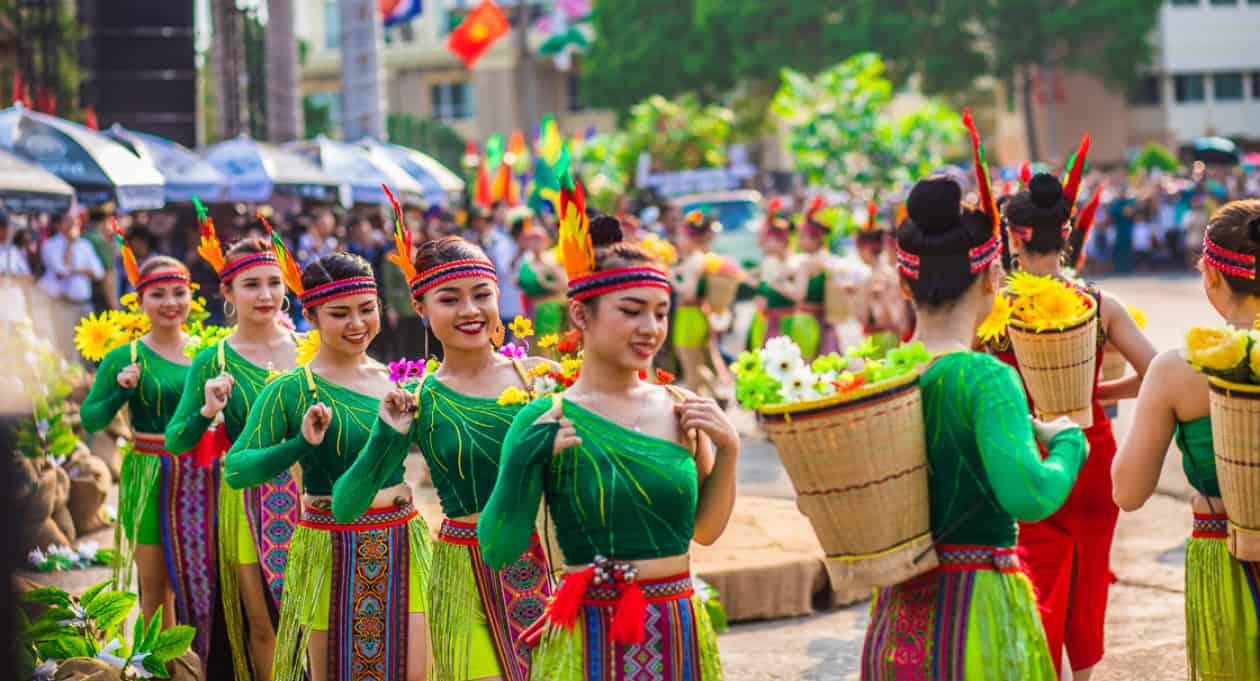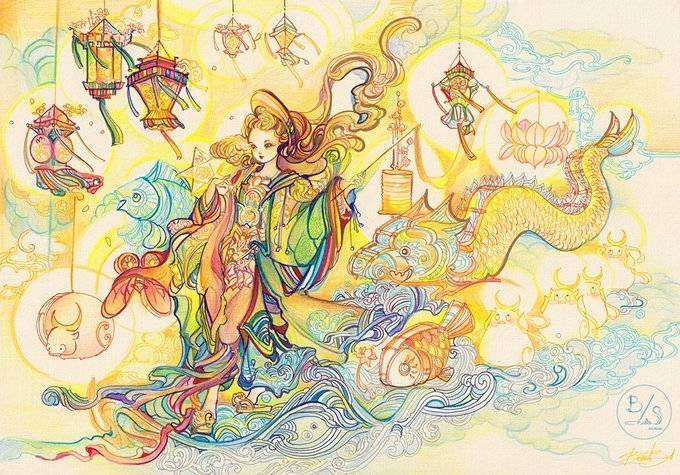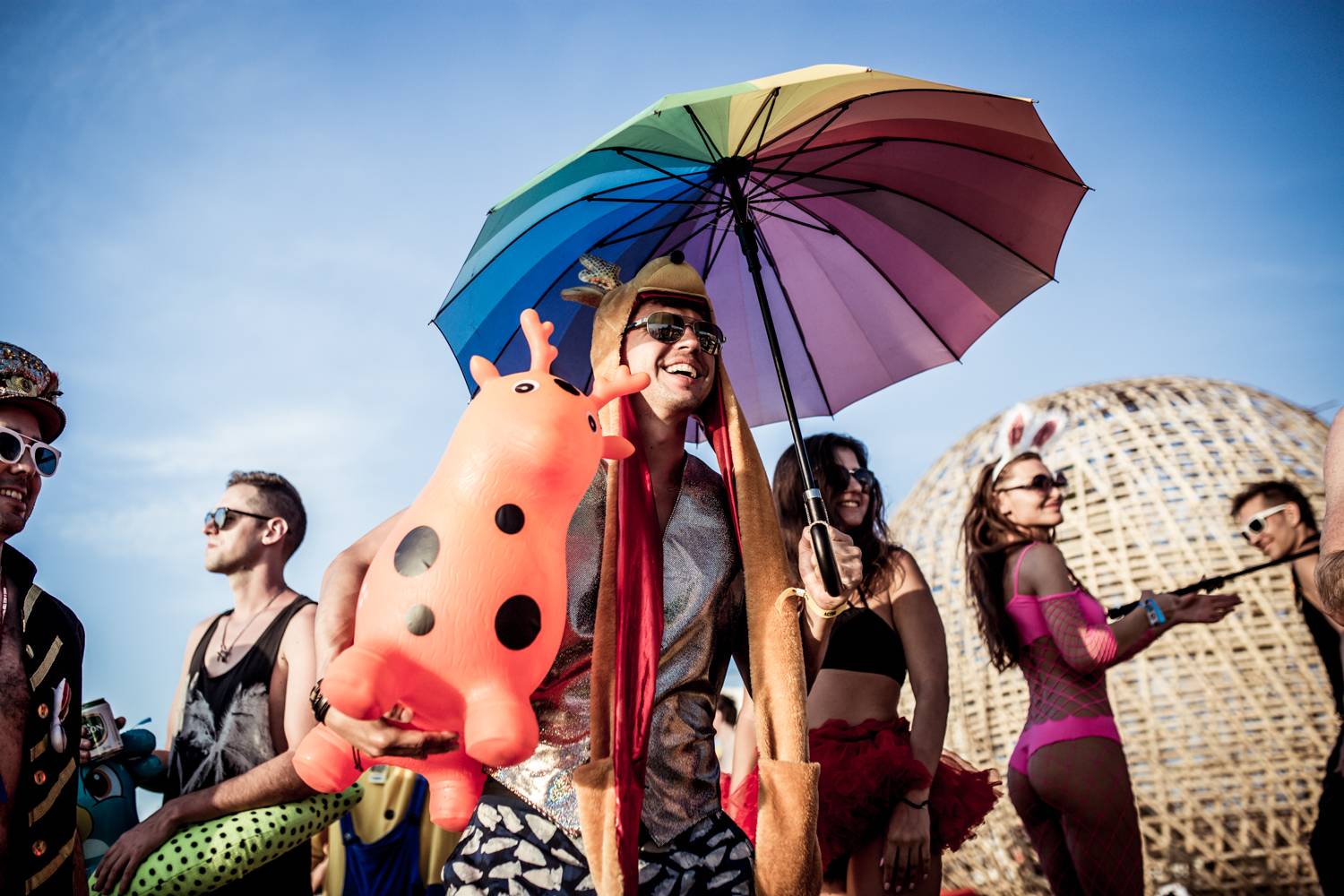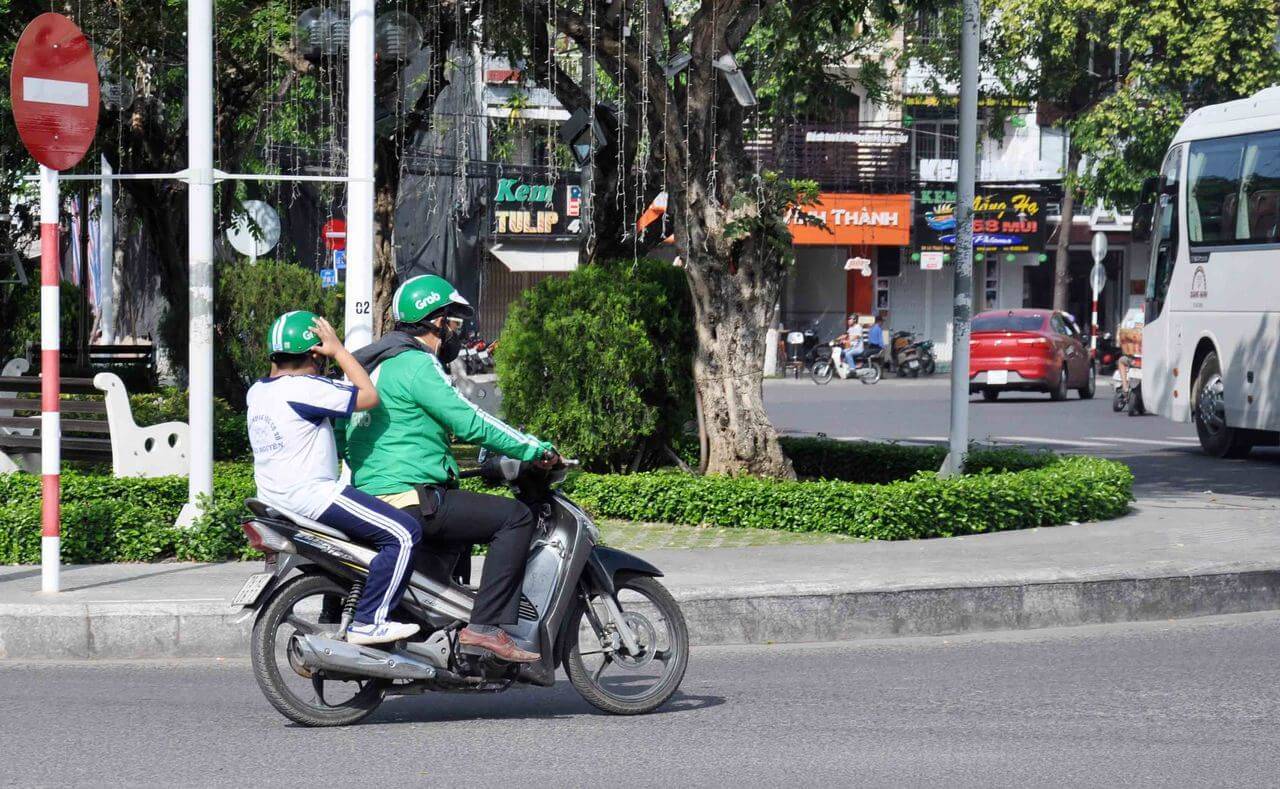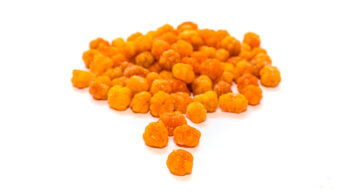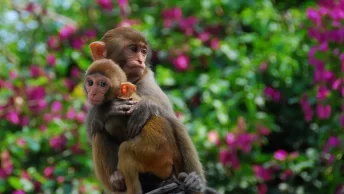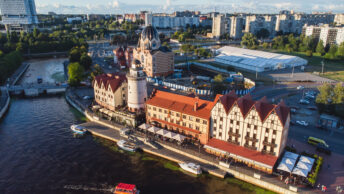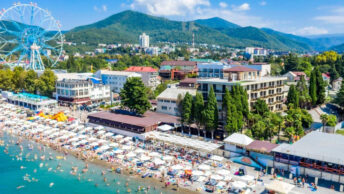March/April: Phu Giay Festival
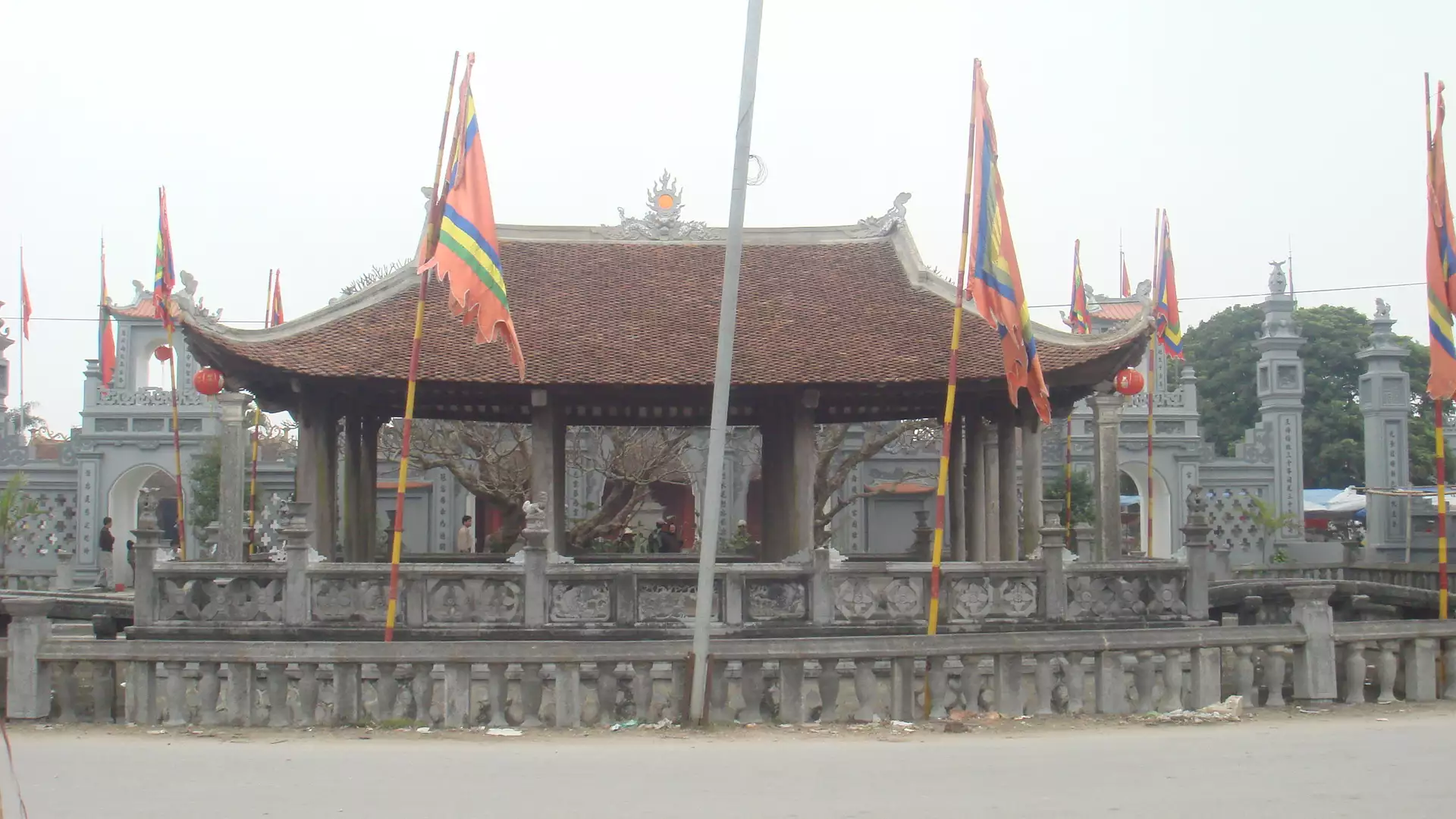
Thang Nguyen/Wikimedia Commons/CC BY 2.0
At Phu Giay Temple in Nam Dinh province, tribute is paid to Lieu Hanh, one of the Vietnamese “four immortal gods,” and the only one based on a real person (a princess of the 16th century who died young). Many devotees from all over make a pilgrimage to Phu Giay Temple, located about 55 miles east from Hanoi, to join the festival, taking advantage of the traditional lull in work during the third lunar month. Traditional diversions such as cock-fighting, keo chu, and folk singing are held all throughout the festival.
The Phu Giay Festival takes place on the third to the eighth day of the third month of the Chinese lunar calendar. Relative to the Gregorian calendar, the festival occurs on these dates:
Hoi An Lantern Festival
It’s a sight to behold; once a month the shops, businesses, bars and restaurants of Hoi An turn off all forms of electricity and allow for the twinkly glow of candles and lanterns to illuminate the city. The magical event that is Hoi An Lantern Festival coincides with the full moon, which is a particularly sacred time on the Buddhist calendar as it’s believed Buddha was both born and gained enlightenment during the full moon. Most of the action takes place in the Ancient Town and along the Hoai River, where lanterns of all colours, shapes and sizes illuminate the streets and float peacefully on the water. This lantern festival on Vietnam’s central coast is one not to miss.
Trung Nguyen: The Ghost Festival
This bizarre celebration is the second largest festival in Vietnam. It usually falls on the 15th day of the seventh month but the celebrations are held anytime during the latter half of the month. Even if you’re not religious, this celebration is celebrated, acknowledging the existence of good and evil. The Vietnamese people believe that everyone has two souls, a spiritual soul and your material soul (Hon and Via). When your person dies, they believe that your soul is sent to either heaven or hell and is judged by ten justices, sending your soul to either heaven or hell. Wandering Soul’s Day or the Ghost festival is considered the best day when the living pray for the sinful souls, giving them a chance to go to heaven. On this day, they believe that the fates of hell are opened and souls can fly out.
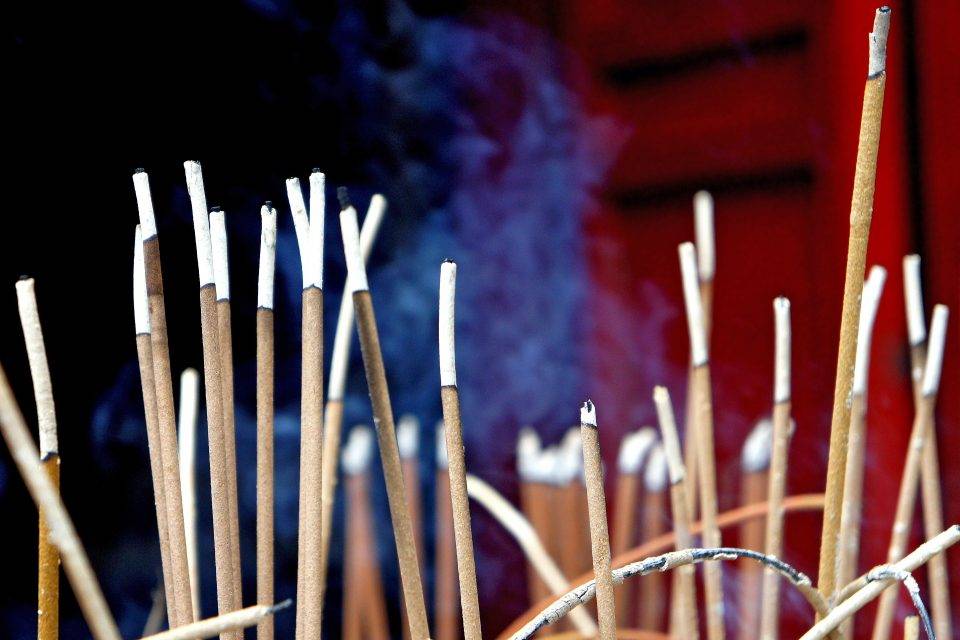
Tet: Vietnam’s Most Important Holiday
Originally, Tet or Tet nguyên dán was celebrated by farmers to thank the gods for the arrival of Spring. However, through the years, Tet has turned into the official Vietnamese New Year. The celebration often lasts for three days and is very similar to the way the Chinese celebrate their New Year. The streets are donned with flowers, people decorate their homes, and families often get together to celebrate this special holiday. During these three days, the Vietnamese have certain traditions and customs that they follow to help usher in prosperity in the New Year. There is a lot of information online regarding Tet with mixed information on whether it is a good time for travellers to visit.
Read: Reasons Why not to Visit Vietnam 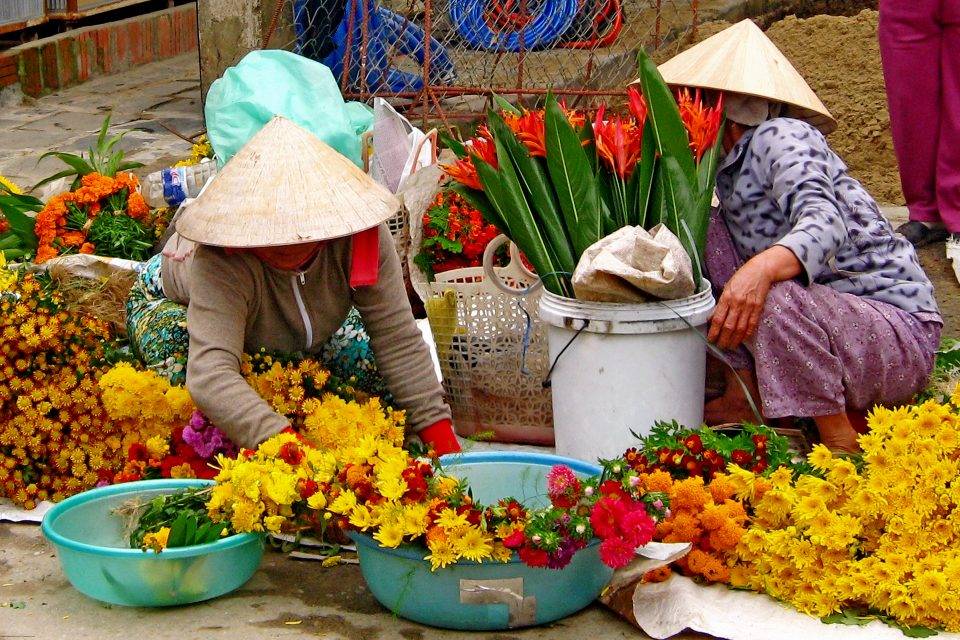
Tet is a family celebrated holiday which means people flock to the provinces, often leaving cities and beaches like a ghost town during the main celebration day- which doesn’t necessarily have to be a bad thing. One downside to this is that transportation and getting around places is a lot more difficult. Flights are often booked and are expensive and some bus routes are often always full. However, with that being said, there is still loads to see on the days leading up to the actual celebration. Cities and houses are decorated with flowers, lanterns and all sorts of pretty decoré. There are also a variety of Vietnam travel experiences which you can prebook in advance in order to make sure they are available during the holiday season.
Want to Have a More Local Experience While Traveling?
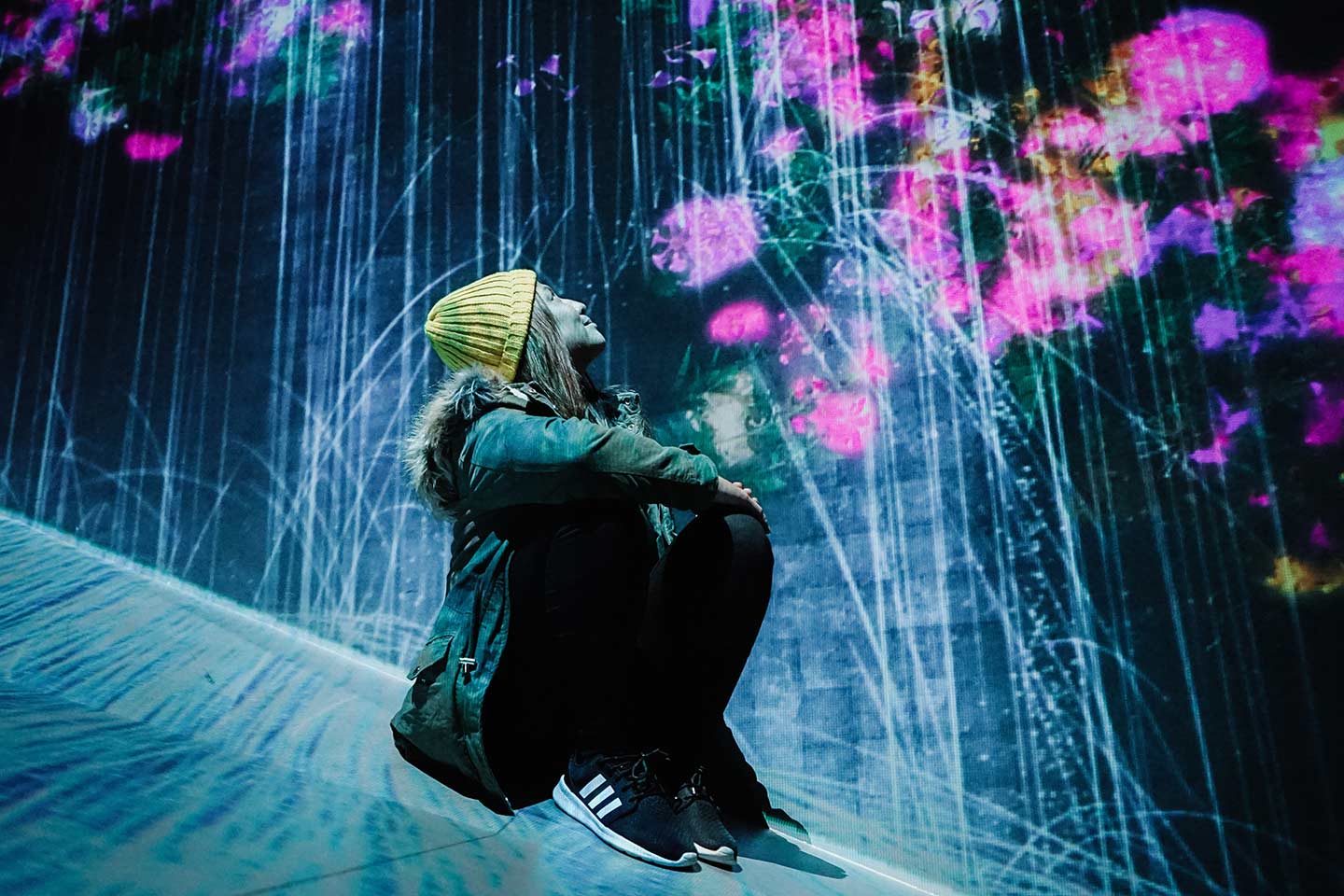
Avoid cookie-cutter tours made for mass tourism. Wherever we are, we love going on local Airbnb Experiences as they have unique experiences around the world.
Click the button below to find a local experience near you.
View Airbnb Experiences
September
2 September – National Day
4 September – National Day Holiday
National Day
National Day commemorates the Vietnam Declaration of Independence from France on 2 September 1945. A festival atmosphere can be felt across the country as flags are hung, bars and restaurants extend their hours and streets are closed to traffic for patriotic street parties. In Hanoi, the streets around Hoan Kiem Lake become pedestrian-only and fill with performances and an array of vendors selling tasty street food. In Saigon, fireworks and a street party fill Nguyen Hue Street.
Tet Trung Thu (Mid-Autumn Festival) – Late September/Early October
This popular festival belongs to the children, but is still fun for adults too. With ancient roots rich in myth and legend, travellers will delight in seeing kids performing lion dances and participating in street processions. It’s also customary to give and receive Banh Trung Thu, or boxes of mooncakes, during this time. Filled with lotus seeds, red beans and sometimes a yoke from a salted egg to represent the moon, don’t miss tasting this traditional festival food.
For a current list of public holidays in Vietnam go to www.worldtravelguide.net/guides/asia/Vietnam/public-holidays.
10. Phu Quoc[SEE MAP]
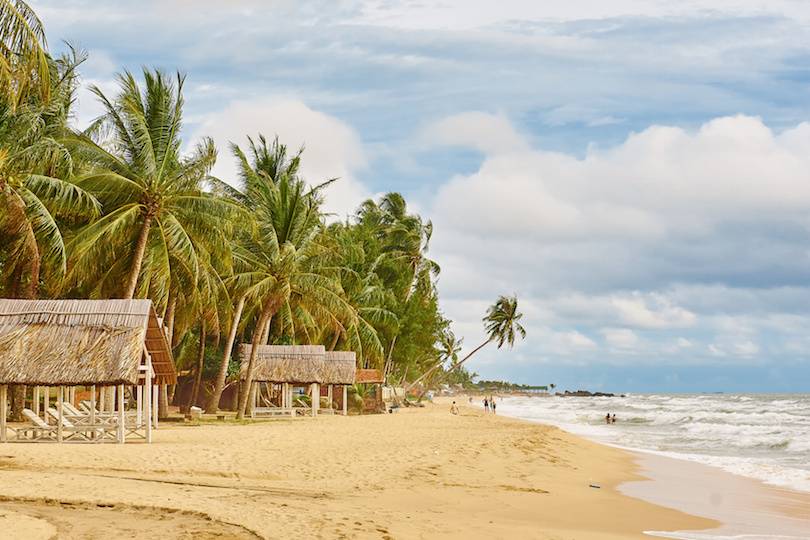
Phu Quoc is a scenic island in the Gulf of Thailand. While it officially forms part of Vietnam, it is actually closer geographically to Cambodia. Today, it’s characterized by dense tropical jungle, soft sandy beaches, and undulating hills. But the island has a fascinating history, having served first as a French missionary base and then as a French colonial wartime prison – a gloomy reformatory that you can visit today.
History aside, the island is most tempting for its alluring tropical nature. Days in Phu Quoc are spent sunbathing on sandy beaches, scootering around fishing villages, visiting pearl and pepper farms, and, if you’re up for it, trekking to waterfalls.
An island that’s famous for its seafood, don’t miss an opportunity to try out Phu Quoc’s famous fish sauce (nuoc mam) – you can even visit one of the fish sauce factories while you’re here!
4. Hue[SEE MAP]
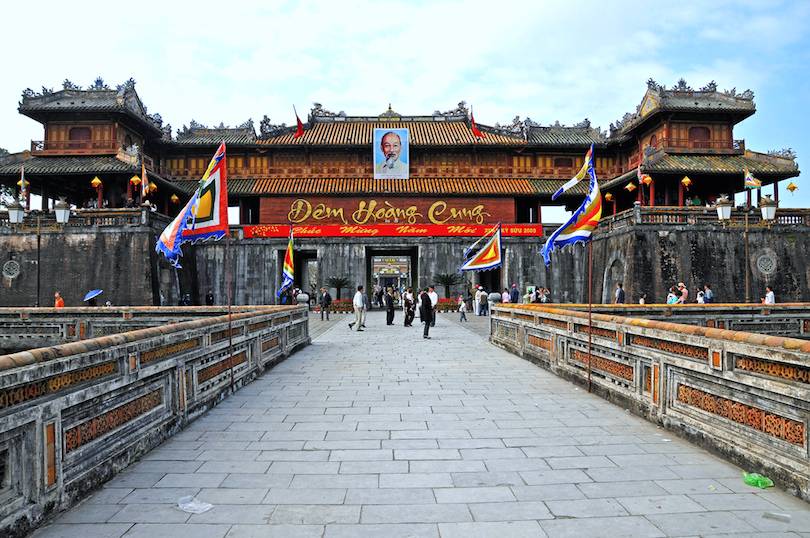
Hue – formerly known as the Panduranga of Cham Kingdom – was once the imperial capital of Vietnam. Located in the central region, Hue had a huge role to play in the Vietnam War. Captured by the Viet Cong for a total of 24 days, thousands of people were killed here if they were thought to be sympathizers of the south.
Today, the city is split in two by the Perfume River. The old city with its ancient ruined citadel lies to the north and the modern-day city to the south. The Demilitarized Zone, which marks the official former border, is one of the most popular day trips from Hue while the Thien Mu Pagoda is the city’s official symbol.
Of the city’s monuments, the Citadel is the most famous. Once the seat of the Nguyen emperors, the Citadel is a sprawling complex of grand palaces, ornate temples, walls and gates. Prime attractions within the Citadel are the Forbidden Purple City, Thai Hoa Palace, and the Ngo Mon Gate. Another important landmark on the river is the city’s official symbol, the Thien Mu Pagoda.
A stroll along the promenade is also recommended, through the statue-abundant parks and onwards by scooter or boat cruise to the Tombs of the Emperors on the outskirts of the city. Dating back to the 19th and 20th centuries, the Tomb of Tu Doc, with its striking Buddhist architecture is the cherry on top.
See also: Top Hue Attractions
February/March: Perfume Pagoda Festival
Andreas Mohaupt/Getty Images
The Perfume Pagoda Festival is Vietnam’s most famous Buddhist pilgrimage site, welcoming hundreds of thousands of pilgrims who arrive at the sacred cave to pray for a happy and prosperous year ahead.
This stream of pilgrims reaches its peak at the Perfume Pagoda Festival—devotees travel through a picturesque gauntlet to the sacred caves, first boarding boats that pass a landscape of rice paddies and limestone mountains, then going by foot past historical shrines and up hundreds of stone steps.
The Perfume Pagoda Festival takes place on the 15th day of the first month of the Chinese lunar calendar. Relative to the Gregorian calendar, the festival occurs on these dates:
Hung Kings’ Festival
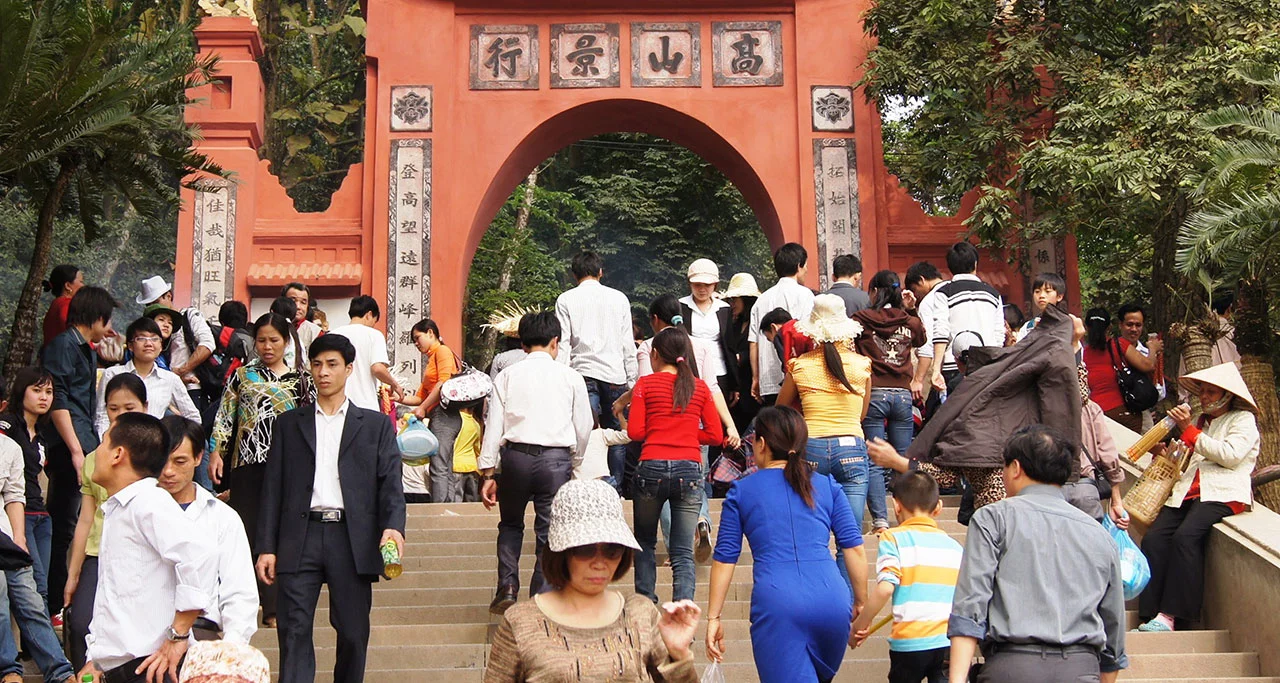
Many visitors take part in Hung Kings’ Festival in Phu Tho Province
Time: from 8th – 11th day of the 3rd lunar monthVenue: Viet Tri City, Phu Tho Province.
Hung King Temple Festival is held annually in Phu Tho Province (~ km from Hanoi) to commemorate the 18 Hung Kings – the nation founders. This festival lasts 4 days, from the 8th to the 11th day of lunar March. The atmosphere of the festival is always bustling with many different folk games including human chess, bamboo swings, rice cooking competitions, wrestling, lion dance, etc. The highlight of the festival is the palanquin procession and incense-offering up to Upper Temple (Den Thuong) on the 10th day with participation of governmental leaders, villagers, and many visitors.
Tet Nguyen Dat
Of all of Vietnam’s festivals and celebrations, Tet Nguyen Dan – or Lunar New Year – is the biggest. Usually falling in late January, think of it as Christmas, New Year’s Eve and Easter all rolled into one. Friends and families come together to feast on traditional holiday foods, time is spent praying and lighting candles at temples, children are gifted lucky money, and fireworks explode across the night sky. Houses, shrines and shops are decorated in bright hues of red and yellow (the Vietnamese believe these colours bring good fortune), while public stages are set up to host cultural performances. Just keep in mind that during the Lunar Festival in Vietnam many attractions and restaurants in smaller towns shut down, so it’s a good idea to stick to the larger cities.
Wandering Souls Day
If you’re travelling through Vietnam on the 15th day of the seventh lunar month, it’s best be on the lookout for spirits, ghosts and ghouls – it’s believed the gates of hell are thrown open on this fateful day. Wandering Souls Day, often referred to as the Ghost Festival, is a time when all sinful souls who were condemned to hell have the opportunity to return to their mortal homes and seek absolution. Those who are Earth-side flock to Buddhist temples and graves, bringing offerings of flowers and food for any ancestors that return, while paper money is also burnt to honour them. Hue and Hoi An are considered the epicentres of this sacred event, which is more about sombre reflection and prayer than it is wild celebrations.
Mui Né
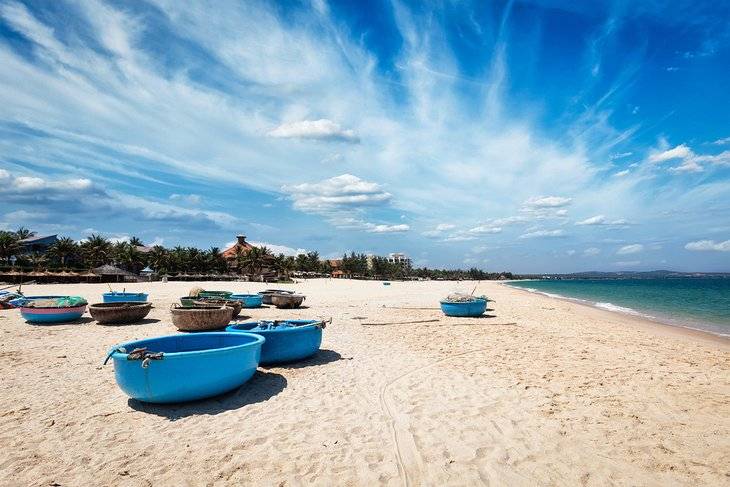 Fishing boats on the beach in Mui Ne
Fishing boats on the beach in Mui Ne
Once a sleepy coastal fishing town, Mui Né has developed into a beautiful beach resort town and a prime destination for windsurfing, sailing, and kitesurfing.
Compared to other beach destinations in Vietnam, however, Mui Né remains relatively unknown – and this means pristine beaches and a quiet retreat for most of the year.
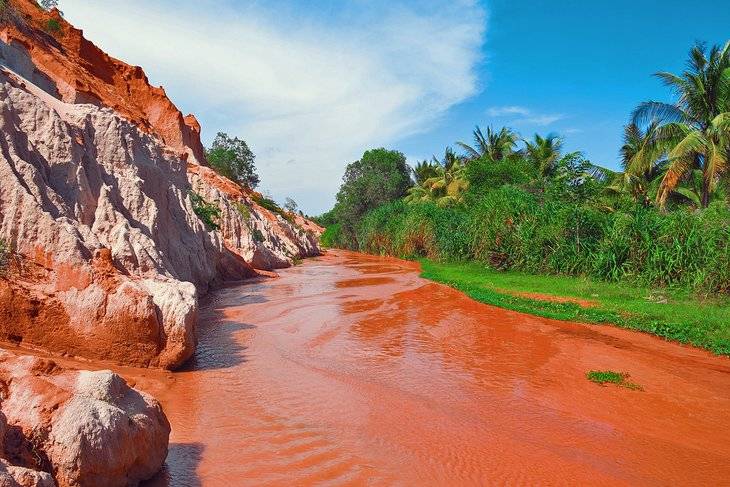 Red cliffs and river in Mui Ne
Red cliffs and river in Mui Ne
One of Mui Né’s most unique attractions is the natural Red Sand Dunes just outside town, where visitors can practice sand-sledding or rent dune buggies for a more adrenaline-charged experience.
Tucked away between nearby fishing villages and towering orange limestone formations, there’s the fairy stream, a slow-moving warm stream that almost feels like a walkway because it’s so shallow – follow it to the end to reach a waterfall.
For those wishing to explore beyond the coastline, there’s also the ruins of the Po Shanu Cham Towers – remnants of the Cham Empire that dominated the area many centuries ago.
Accommodation: Where to Stay in Mui Ne
Mid-Autumn Festival in Vietnam
The Mid-Autumn Festival, or Tet Trung Thu in Vietnamese, is marked with fanciful lanterns to help a legendary moon-bound figure back to the Earth. It is held on the 14th and 15th day of the lunar month which features a wide range of activities such as children carrying paper lanterns, lion dances, and food booths selling mooncakes, sticky rice, fruits, and various sweets. Also known as the harvest festival, households set up an altar during the Mid-Autumn Festival night, on which they display offerings to honor the full moon.
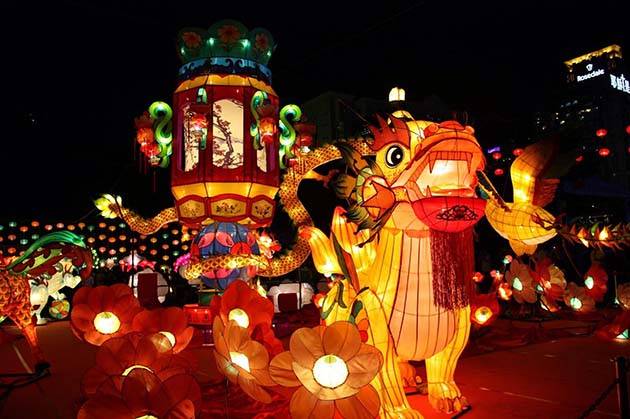
Mid-Autumn Festival is best enjoyed in Hoi An, where you’ll get to see plenty of street performances, lantern processions and art exhibitions throughout UNESCO-listed Ancient Town. Children also participate in essays, drawing and coloring contests during Mid-Autumn Festival, while visitors can enjoy breathtaking sights of colorful paper lanterns along the Thu Bon Riverside.
Songkran Water Festival
Location: Thailand
When: April 13 – 15
To celebrate the traditional New Year, Thailand’s Songkran Water Festival is held every April all over the country. But Chiang Mai’s take on Songkran is legendary and not to be missed, after all it is the most anticipated holiday in Thailand.
Sprinkling water has always signified for Thai people, blessing, purging and newness. In this fresh take on old school beliefs persons of all ages come out armed with super soakers or buckets of water, ready to soak strangers and friends alike.
Festivities include bubbles, performances from professional dancers, religious processions and other fun ways to keep cool.
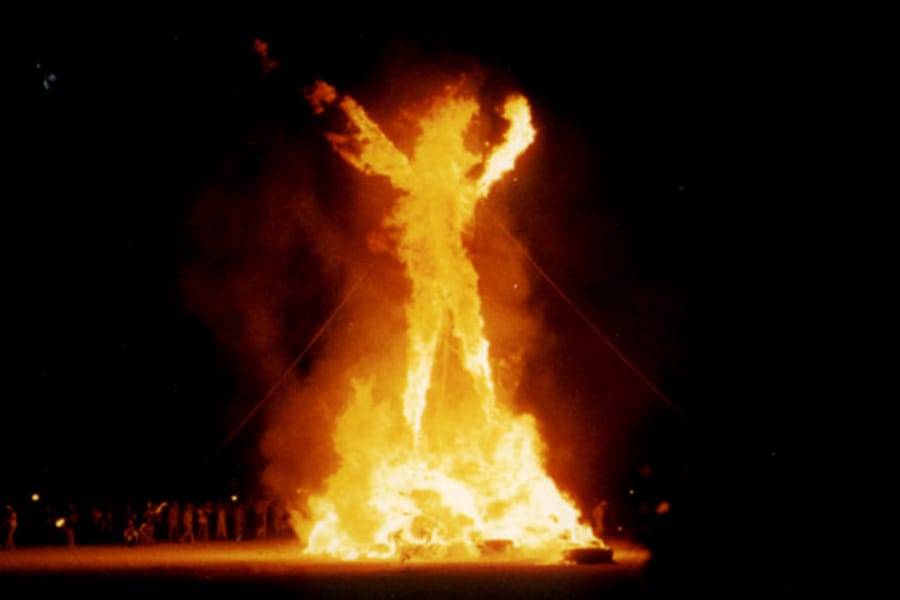
Aaron Logan / flickr (CC BY 2.0)
1. Ha Long Bay[SEE MAP]
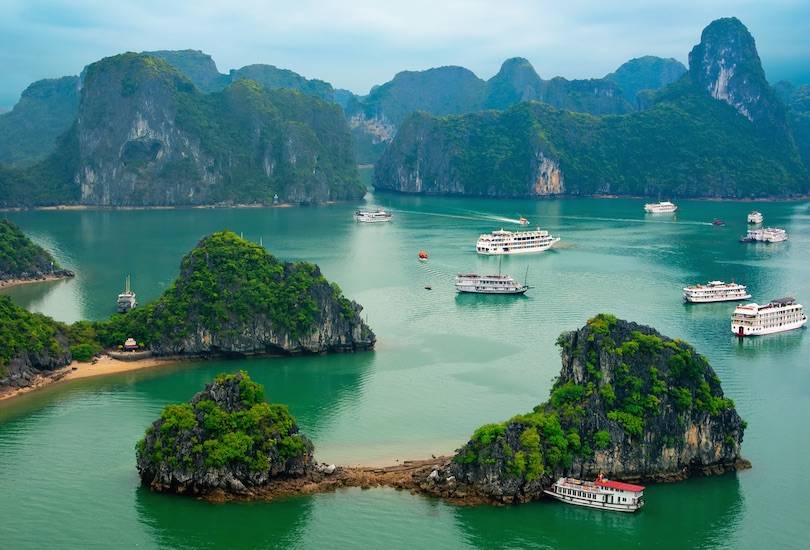
Located about 130 km (80 miles) east of Hanoi in northern Vietnam, Halong Bay is celebrated for its gorgeous emerald-hue waters, thousands of spectacular limestone karsts, astonishing waterside caves, and beautiful tree-topped islands. It’s a popular location for adventure – scuba diving, kayaking, hiking, and rock climbing can all be enjoyed in and around Cat Ba National Park. For those who wish to simply relax and enjoy the views, there are numerous Halong Bay cruises to choose from, from basic to top-level luxury.
The thousands of islands scattered about the bay are a real mixture, ranging from isolated landmasses home to free-roaming monkeys and antelope to bigger inhabited islands with some fantastic beaches. Boat cruises are the best way to experience the natural wonder of Ha Long Bay. With hundreds of boats ranging from traditional Chinese junks to luxury cruisers, boat tours can vary from day trips to multiple-night journeys. These tours often provide meals, nightlife activities and excursion stops where islands, caves and lagoons can be explored. Most boat cruises are arranged either from Hanoi or from ports such as Haiphong, Halong City and Cai Rong.
As with most holidays on the water, Halong Bay is easily affected by the weather. Plan your trip between March and June to get the most out of your visit. June to September is the off-season, so you can usually get some great deals – just be sure to keep an eye on the weather forecast as monsoons can really put a dampener on your trip.
April/May: Xen Xo Phon Festival
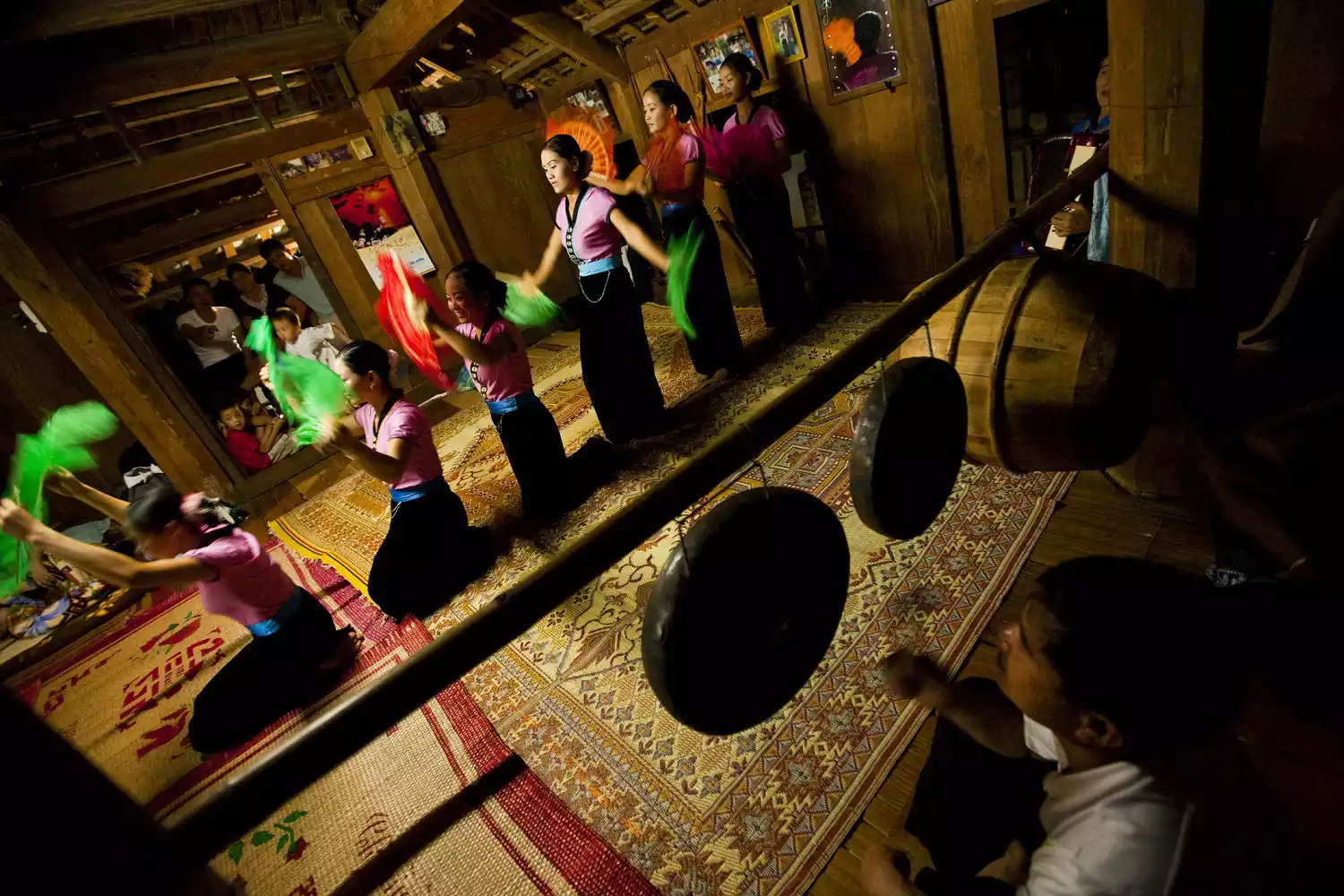
Peter Stuckings/Getty Images
On the fourth month of the Lunar calendar (between April and May), the White Thai peoples of Mai Chau implore the heavens for rain with songs during the Xen Xo Phon Festival. During selected evenings, groups of White Thai make a circuit among the houses in their respective villages, singing songs in the torchlight and receiving offerings in exchange.
The White Thai, ever dependent on the rain for their rice and vegetable harvests, seek help every year from the heavens to pray for more rain to come—the bigger the festival, the more abundant the rains will come when the weather turns.
Visiting Vietnam in summer (June – August)
Visiting Vietnam in June
The rainy season in the south is in full swing and floods are common, and rainfall is increasing in the central highlands. The north is heating up and getting wetter too, meaning trekking can be hazardous – so bring appropriate footwear and outer layers if that’s on your itinerary. But don’t let the rain deter you from visiting Vietnam. The central coast is at its best, so perfect for idling away some time on the beaches near Hoi An Dropdown content, Da Nang Dropdown content and Lang Co, and the south still has plenty of dry hours in the day. Hanoi Dropdown content in the north and the Mai Chau Valley Dropdown content are still mostly dry. Added to which, visitor numbers in Vietnam tend to be fewer in June.
Visiting Vietnam in July
July is a similar story to June: heavy downpours occurring at both ends of the country. Temperatures reach their peak in the north and the central coast is a searing 31ºC, on average. But if you don’t mind a roasting, it’s still a good month to hit the beaches, as there are still plenty of clear days, and the rain offsets some of the heat. Rain in the central highlands means trekking conditions are poor. Also, transport can be more complicated, sometimes washing out roads and cutting off the more remote villages. Hanoi tends to be very wet.
Visiting Vietnam in August
If you’re planning on trekking in Vietnam avoid visiting in August: the mountains of the north and the central highlands are experiencing peak rainfall now. And the deluge of rain at Ha Long Bay Dropdown content means you should forget about going on a boat tour this month. Conditions on the central coast are, on the whole, still pretty good, especially at Nha Trang Dropdown content, although the fine days are coming to an end. While the south is fully ensconced in its wet season, it’s not exactly a bad time to visit, with plenty of rain-free hours in the day to enjoy.
Carnival of Venice
Location: Venice, Italy
When: 40 days before Easter, on Shrove Tuesday
Carnevale di Venezia or Venice Carnival dates all the way back to the 11th century, but came to international acclaim in the 18th century. During the weeks dedicated to Carnival each year thousands of tourists and locals take to the streets in beautiful costumes and masks to enjoy music, dancing, parties and the festive atmosphere.
Festivities also include live theatrical plays featuring intriguing and comical traditional folk characters, lavish 18th century-style galas in beautiful old Venetian buildings, open air street parties and an award ceremony at Carnival’s closing to celebrate the very best costumes and masks.
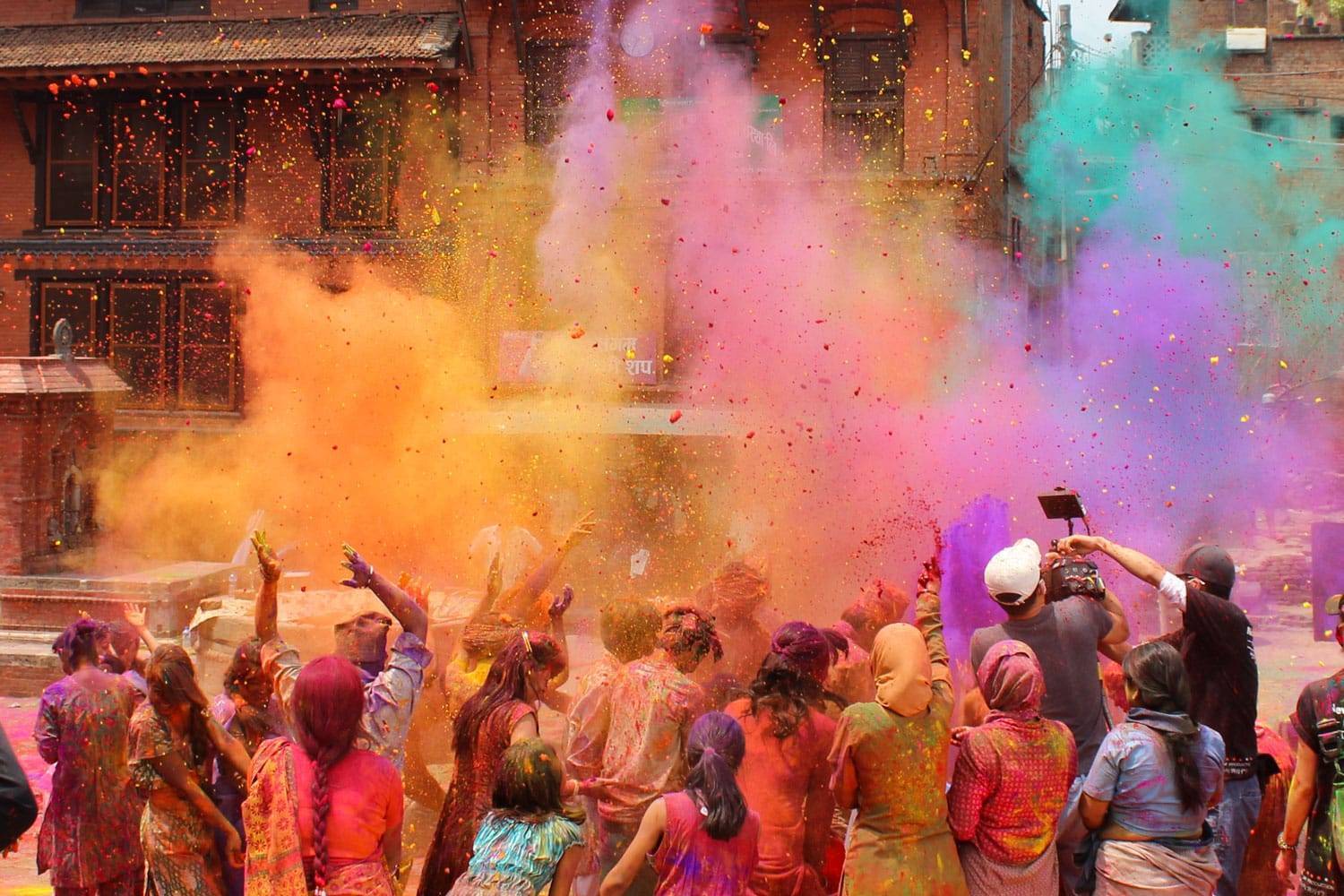
Kristin Ruhs / shutterstock.com
Giong Festival
If you are familiar with Vietnamese Lunar New Year or Mid-Autumn Festival, Giong Festival is quite new and unique to those who first visit Vietnam. Celebrated in springtime in Phu Dong or Soc Temple to commemorate Saint Giong – a great hero in Vietnam’s mythology who defended the country against enemies, Giong Festival has become a meaningful activity to promote local people’s patriotism.
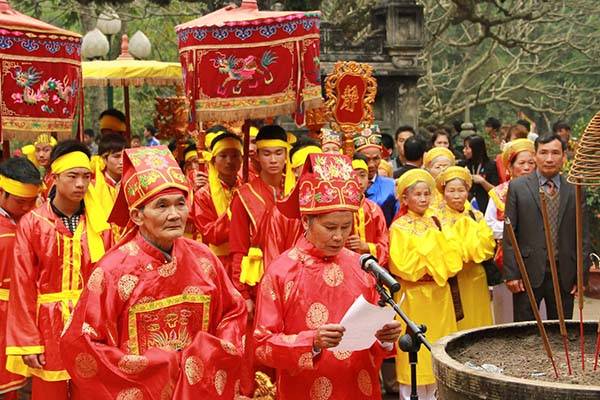 Workship activities in Giong festival
Workship activities in Giong festival
I had such a great time when witnessing old villagers and festival-goers demonstrated processions and incense offerings. Especially, I strongly recommend taking part in a wide range of traditional games and activities encompassing folk games and ancient singing performances. Actually, I was totally mesmerized by all the exciting things here and dream of participating in this amazing traditional festival one more time.
Happy traveling!
Vietnam Festival in May
12. International Labor Day
Basic Information:
- Category: National public holiday of Vietnam
- When is International Labor Day in Vietnam? 1st of May annually. If it falls on a weekend, worker will have the first day of next week off as compensation.
- Where does International Labor Day take place? This is a public holiday in many countries in the world, including Vietnam.
How is this holiday in Vietnam?
May Day or Labor Day is a known as a celebration day or day of rest for workers. This Vietnam holiday is often joined with the Reunification Fay on 30th of April resulting in a double-day off. Administrations are closed on these day.
How does it affect travelers?
This day is not suitable for foreign tourist to visit or travel long distance in Vietnam since the number of domestic travel will skyrocket. It is hard to get a decent hotel room during this time if you don’t book overhead.
Basic Information:
- Category: Traditional festival of Vietnam
- When is Buddha’s Birthday in Vietnam? This festival often falls on the April full moon day in lunar calendar, which converts into April or May in Gregorian calendar
- Where does Buddha’s Birthday take place in Vietnam? People celebrate this Buddhist festival in Vietnam in temples, pagodas and places of worship.
How is this festival in Vietnam?
Vietnam is a country with 12% of the population are Buddhist. Many other people, despite that they do not officially call themselves Buddhist but do practice a lot of Buddhist teachings and philosophy in life as well as do go to temples and pagodas to pray.
On this day, in major cities such as Ho Chi Minh City, Hue, Hoi An… there are many parades held by monks to give out gifts to the poor, the homeless and the ones in need. Many other rituals are performed in pagodas and temples on these days are dropping flower pots to the river, washing Buddha’s pictures and statues, organizing Buddhism teaching sessions and praying for peace. In the evening, candles are lit on floating lotus flower and sent out into rivers around Vietnam by the Buddhist with prayers.
How does it affect travelers?
This day will not affect traveler’s activities at all. Thus, it is a great opportunity for travelers experience an important South-east Asia religious festival in Vietnam.
9. Phong Nha-Ke Bang National Park[SEE MAP]
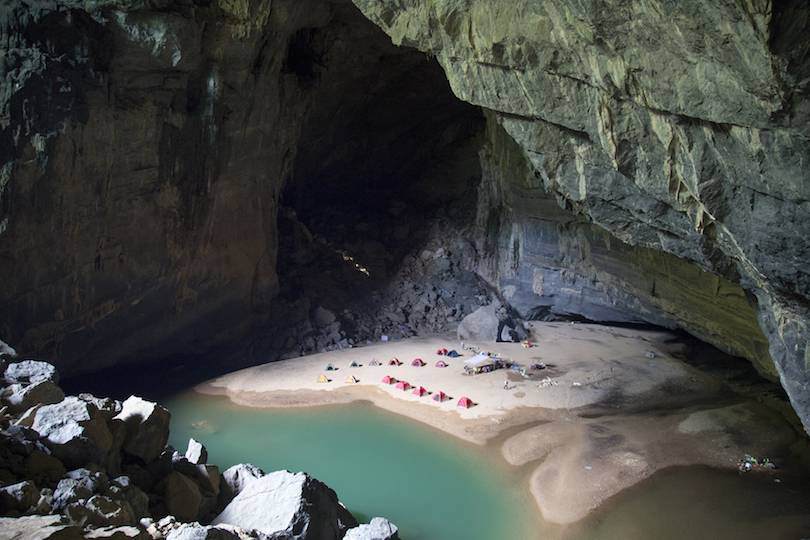
Quangha07 / Dreamstime
Tucked away in the Quang Binh Province in Vietnam’s Central Coast region, Phong Nha-Ke Bang National Park is one of the most picturesque parts of the country. With a steadfast reputation as a filming location for 2017 Kong: Skull Island, and with a nearby international airport, the national park is more popular than ever before.
Opened to the public in 2010, the appeal of Phong Nha-Ke Bang National Park is the escape from the city. Here, you’ll live life in the slow lane as you cycle through Kong jungles at your own pace. Home to 400 million-year-old karst mountains, there are hundreds of caves and secretive rivers to explore. The Son Doong Cave is a must visit. Home to its very own hidden jungle, microclimate, and Underground River, it’s one of the largest caves on Earth.
Due to its location near the Laos border, access to the park is strictly controlled, and visitors can expect to find a strong military presence here. This is mainly due to its war history – the park has some of the world’s highest numbers of undetonated bombs, which is why visitors can only visit this place with a licensed tour guide.
Hoi An
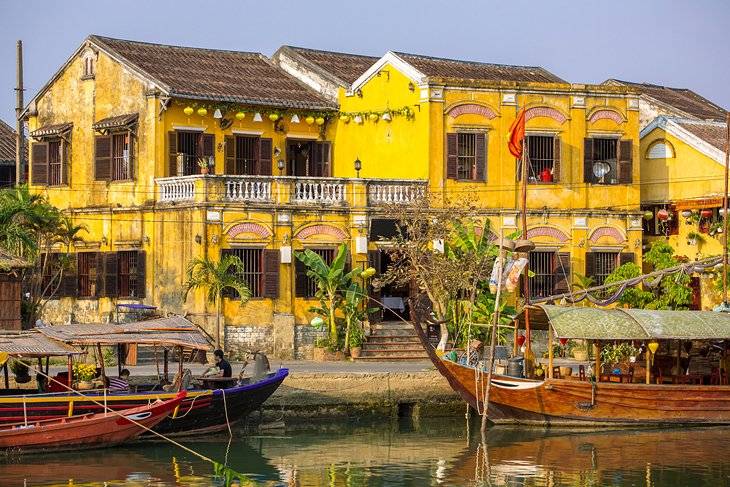 Hoi An
Hoi An
Beautiful Hoi An is the most atmospheric city in Vietnam, with bags of surviving historic architecture.
The old town quarter is a joy to explore, packed to the brim with well-preserved merchant houses that hark back to Hoi An’s trading center heyday of the 15th century, when the town was a major meeting point for Japanese and Chinese merchants who flocked here for the local silks.
Plenty of the old merchant houses have been opened to the public, so you can get a taste of these times. The best is 17th-century Tan Ky House, with fascinating architectural and decorative elements.
Hoi An’s major symbol is the delightful Japanese Bridge at the western end of Tran Phu Street, while nearby, the Assembly Hall of the Fujian Chinese Congregation is the old town’s most highly decorated temple.
There are numerous small pagodas and museums dotted about town, but Hoi An’s true charm is found in simply rambling the old town streets admiring the well-preserved facades.
Accommodation: Where to Stay in Hoi An
Albuquerque International Balloon Festival
Location: Albuquerque, USA
When: Early October
The Albuquerque International Balloon Fiesta is the largest annual international event held in the US. For more than four decades, the first or second week in October has ushered in the magical moving picture show of colorful hot air balloons gliding through the crisp fall air.
From its modest beginnings in the 1970s at a mall parking lot with less than 15 hot air balloons, the Balloon Fiesta has steadily grown to become the largest ballooning event in the world. With nearly 600 beautifully colored balloons being launched annually, Albuquerque International Balloon Fiesta is one of the most photographed happenings on Earth. Laser light shows, fireworks, live band performances and interactive education complete the magic at Balloon Fiesta and ensure that there’s something fun to do or see for everyone.
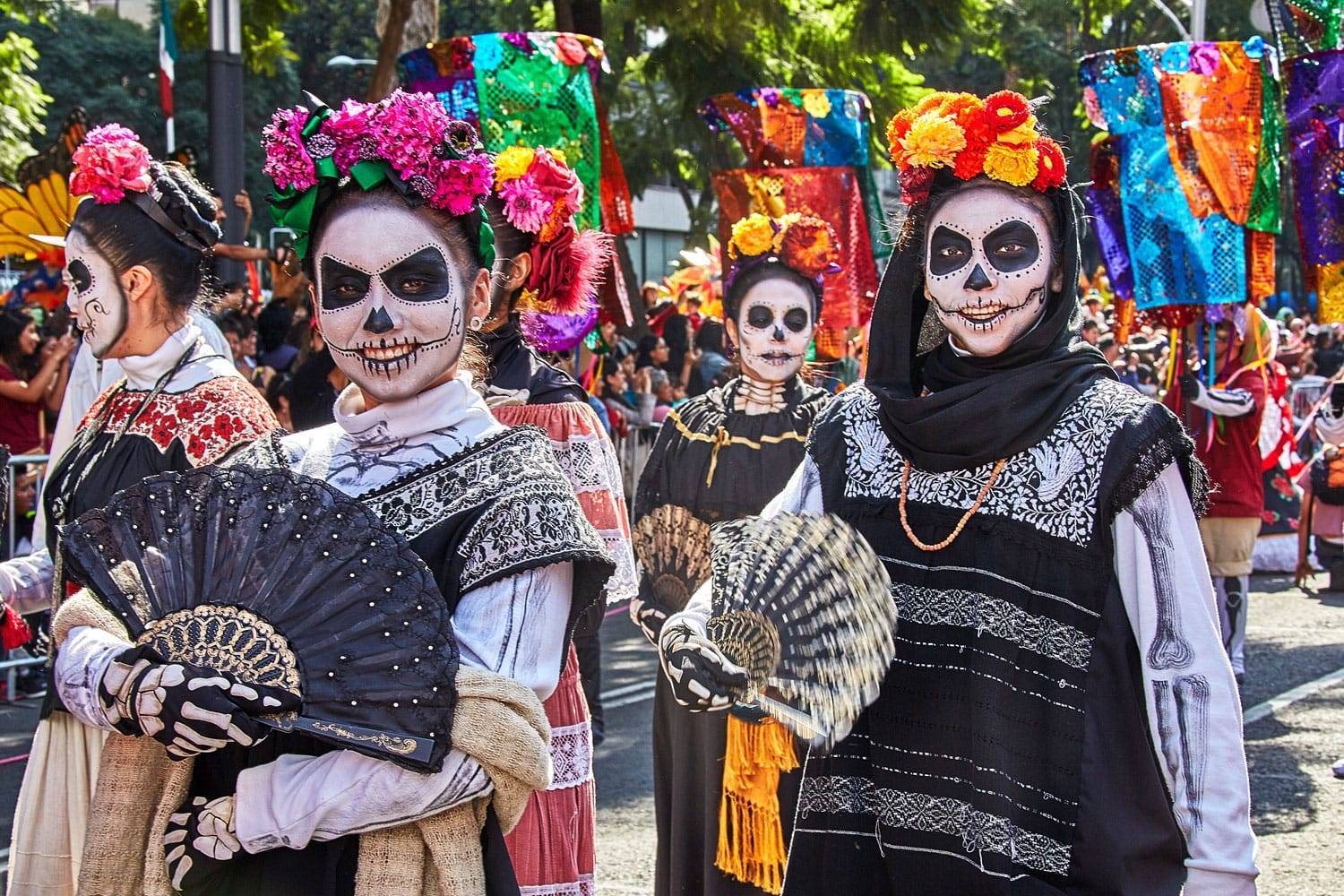
Dina Julayeva / shutterstock.com
March/April: Thay Pagoda Festival
Tran Tuan Viet/Getty Images
If any Buddhist monk deserved worship, it was Tu Dao Hanh, who was an innovator and inventor. He made numerous advances in medicine and religion but is mainly remembered for inventing Vietnamese water puppetry.
The Thay Pagoda Festival celebrates Tu Dao Hanh’s life with a procession of the monk’s worshipping tablet, borne by representatives from four villages. The festival is celebrated by laymen with many water puppetry performances, particularly at the Thuy Dinh House in front of Tu Dao Hanh’s pagoda. The Thay Pagoda is located about 18 miles southwest from Hanoi, or about a 30-minute drive from the capital.
The Thay Pagoda Festival takes place on the fifth to the seventh day of the third month of the Chinese lunar calendar. Relative to the Gregorian calendar, the festival occurs on these dates:
My Son
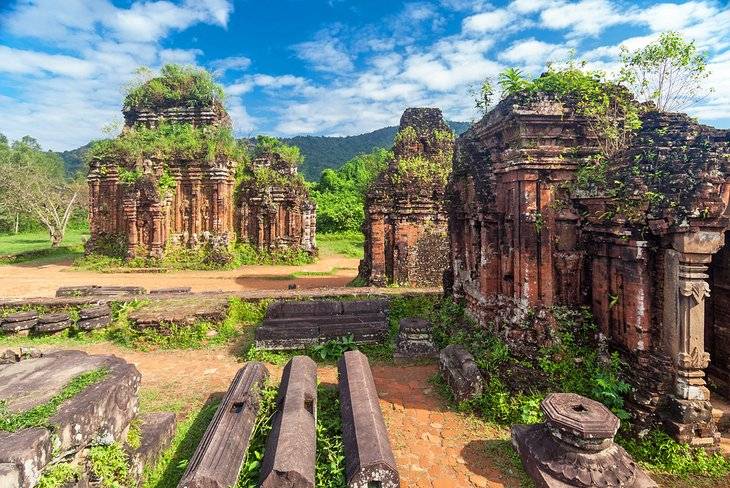 Hindu temple ruins at My Son
Hindu temple ruins at My Son
Surrounded by lush jungle-covered mountains, My Son is a ruined Cham era temple city that dates from the 4th century.
This old Hindu religious center was still very much in use during the 7th to 10th centuries and only fell into complete decline and abandonment during the 13th century.
There are around 20 temple structures still standing here, all built of brick or sandstone blocks and showing interesting influences from various Asian empires, including Indian and Malay.
Note that the temples of Group B are the oldest, while Group A once contained the site’s most important monument but was destroyed deliberately by US forces during the Vietnam War.
A good museum on-site houses plenty of information on the Cham.
Access to My Son is from Hoi An.
Accommodation: Where to Stay in Hoi An
Top biggest Vietnam Festivals that you should not miss:
Lunar New Year (around January, February)
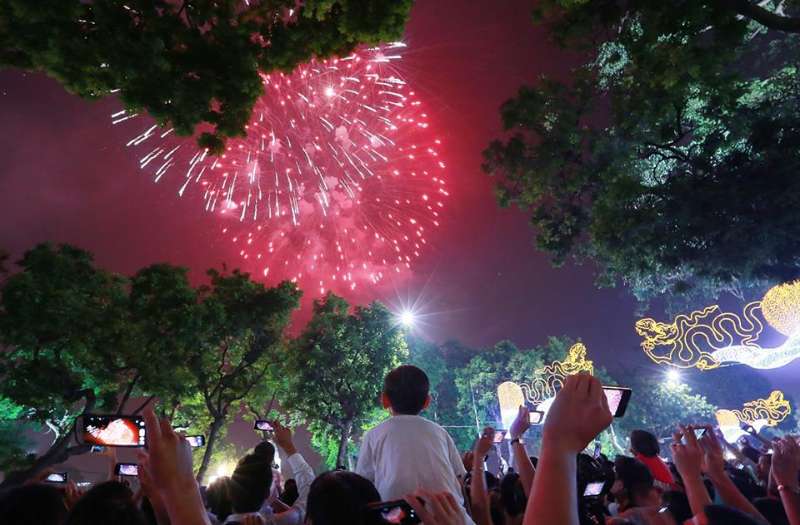
Lunar New Year is the biggest festival of the year in the whole country. It is a chance for people to reunite with their families and to pray to have good health at the beginning of the year as well as to visit temples, pagodas in. New Year times.
Hue Festival (In April / May / June every two years, Hue)
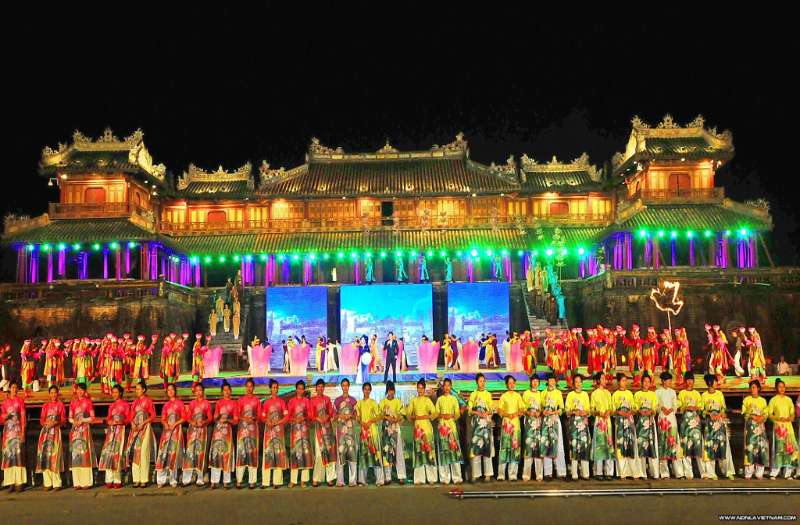
Hue Festival is a celebration of the “Hue City is recognized as a UNESCO World Heritage Site“. There are many cultural events, games, and performances throughout the weeks.
The festival was first held in 2000, to preserve the traditional customs of the Nguyen dynasty. Numerous special events at the festival include the Hue Poetry Festival, Drum and Percussion Debates, The Ao Dai Fashion Show, sports activities such as kite flying, boat racing, and human chess, movie screenings. and art exhibitions.
Perfume Pagoda Festival (February / March annually – Hanoi)
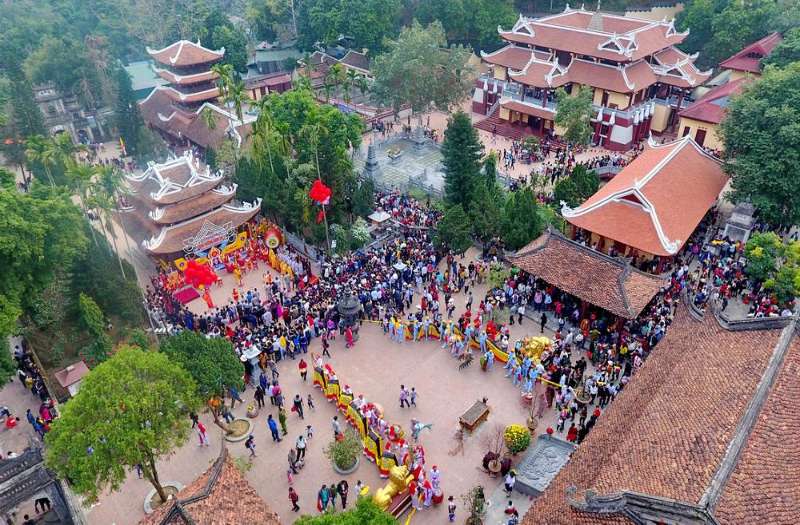
Each year on the occasion of the Perfume Pagoda Festival, many pilgrims from all over the country pray for a prosperous year and pay homage to the Buddha. This is also one of the top Vietnam festivals.
Mid-Autumn Festival (mid-September)
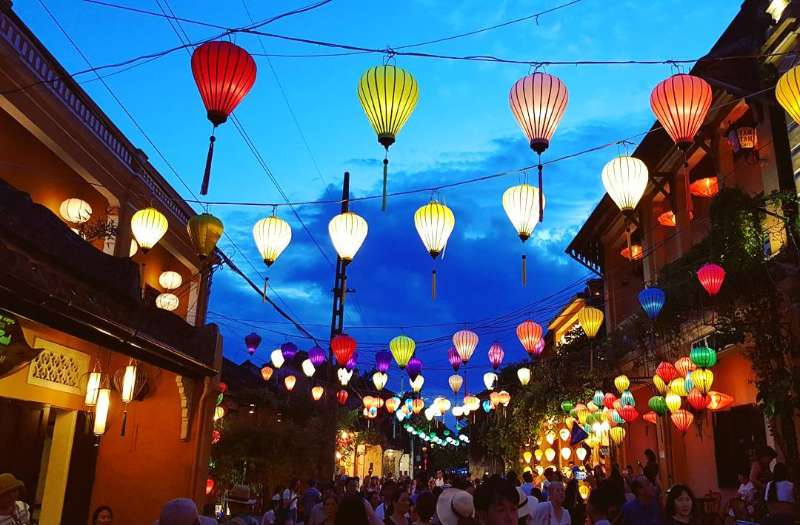
The Mid-Autumn Festival is held on the 14th and 15th of August with lunar lanterns, star lights, lion dance, moon cake stalls and a variety of candies. The most beautiful Mid-Autumn Festival takes place in Hoi An with ancient streets full of lantern procession, and special folk art performances.
Read more:
- Mid-Autumn Festival Vietnam: What is it and how is it celebrated?
- Origin and meaning of Vietnam mooncake
Hung Temple Festival (In early April each year)
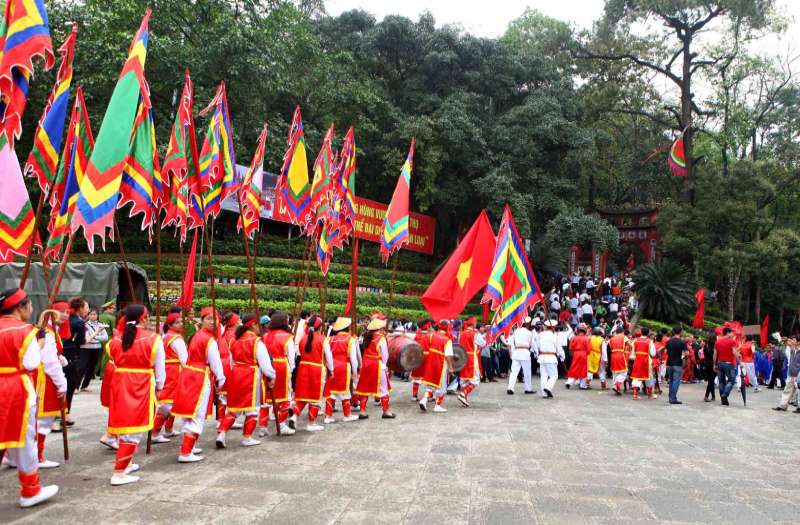
Hung Kings death anniversary or Hung Temple festival is a Vietnamese National holiday. This is the traditional festival of the ethnic people remembering the construction work of Hung Kings.
Read more:
Discover the identity of Vietnamese ethnic groups at the Hung Temple Festival
Lim Festival in Bac Ninh (mid-February)
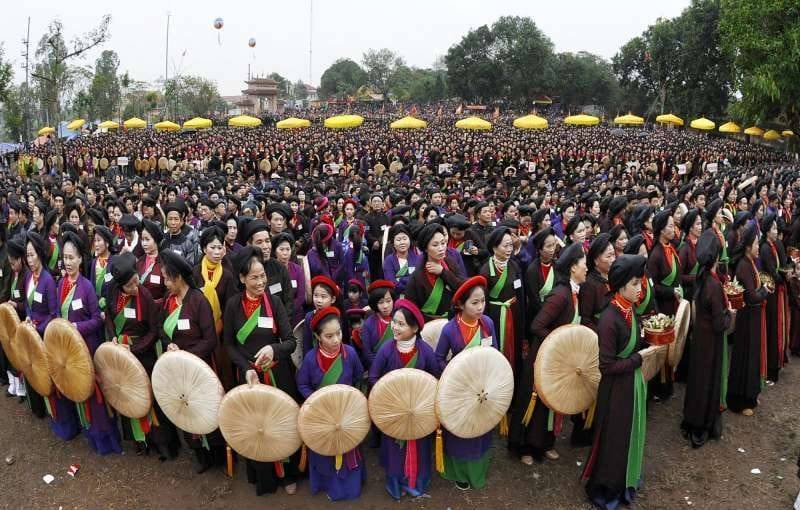
Lim festival is a big festival of Bac Ninh province, the festival is held on January 13 every year in Tien Du district, Bac Ninh province. Lim festival is considered the unique crystallization of Kinh Bac culture.
Hoi An Lantern Festival (14th every month in lunar calendar)
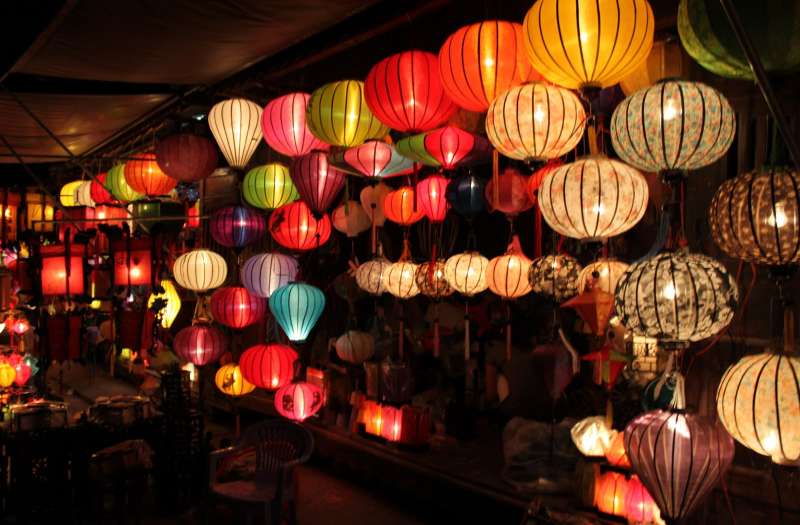
The Hoi An Lantern Festival is a fascinating monthly event featuring paper lanterns lit up the Old Quarter. The festival is held in Hoi An ancient town and along the ancient streets is the best place to experience.
Buddha’s Birthday (late April – early May every year)
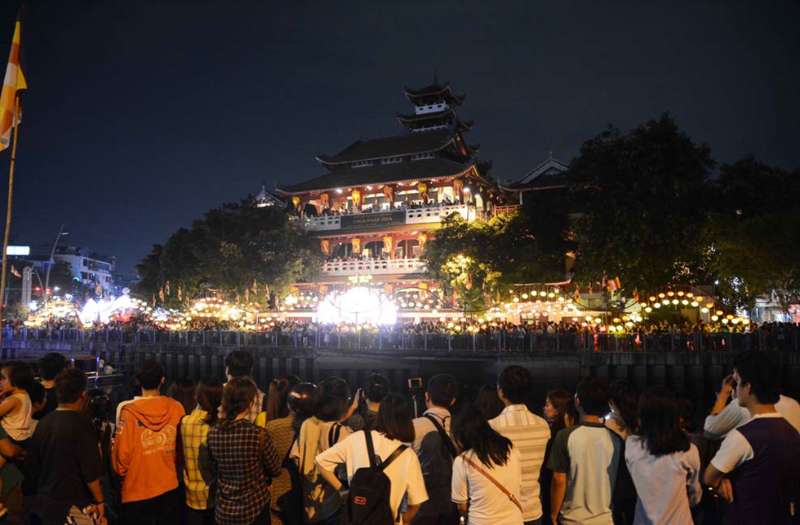
Many practical activities are held in many localities across the country to mark the birthday of Lord Buddha which falls on the 15th day of the fourth lunar month.
Hung King Festival
Hung King Temple Festival is held in commemoration of King Duong Vuong, who became the first king of in 2879 BC. Details of its origin remain sketchy, but the story has become quite prominent over the years: born from the union of a mountain princess and a sea dragon, the Hung King came from a hundred sons hatched from a hundred eggs laid by said princess. Half of the sons returned to the sea with their father, while the rest stayed behind with their mother and learned to rule. To remember the brave sons of this lineage, people gather at the Hung Temple which located near Viet Tri City in Phu Tho province, about 50 miles from Hanoi. Festivalgoers light incense, make offerings, and beat bronze drums at the temple, then join a temple fair, which includes entertainments such as traditional Vietnamese operas and sword dances. This holiday is traditionally held on the tenth day of the third lunar month. Since 2007, the Vietnamese government has declared this to be a nationwide holiday. Hung King Temple Festival not only attracts visitors across the country for its special traditional cultural activities, but it is also a sacred trip that goes back in time to the origins of Vietnam. People often show their love and pride of their homeland and ancestral land. This religious belief deeply embedded in the minds of every Vietnamese citizen, no matter where they originate.
Halong Bay
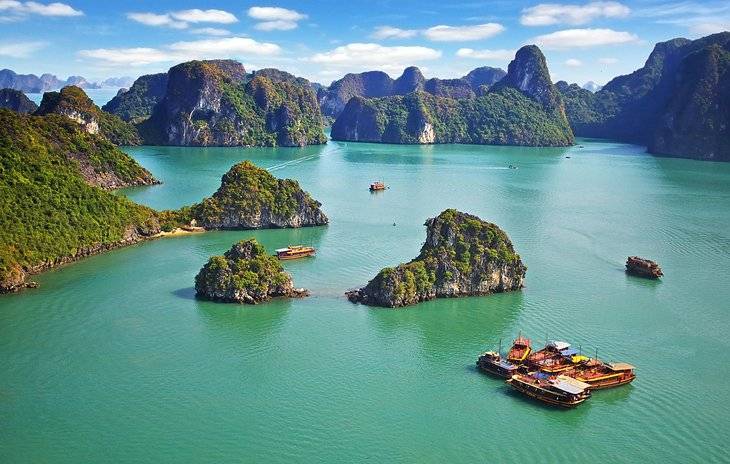 Halong Bay
Halong Bay
The karst seascape of Halong Bay is one of the best places to visit in the world for spellbinding sea views and is a UNESCO World Heritage Site.
Thousands of limestone islands sit within this bay in the Gulf of Tonkin, eroded into jagged pinnacles by wind and water action over millennia.
With the bay’s scenery best seen by boat, this is prime cruising territory. Opt for at least an overnight tour to see Halong Bay’s iconic views as a day trip doesn’t do it justice.
There are plenty of caves in the bay that can be entered including the Hang Sung Sot, with three mammoth caverns, and the Hang Dao Go, with superbly weird stalagmites and stalactites. For most people though, the highlight is simply cruising amid the karsts and soaking up the changing scenery of pinnacles as you pass by.
Accommodation: Where to Stay in Halong Bay
